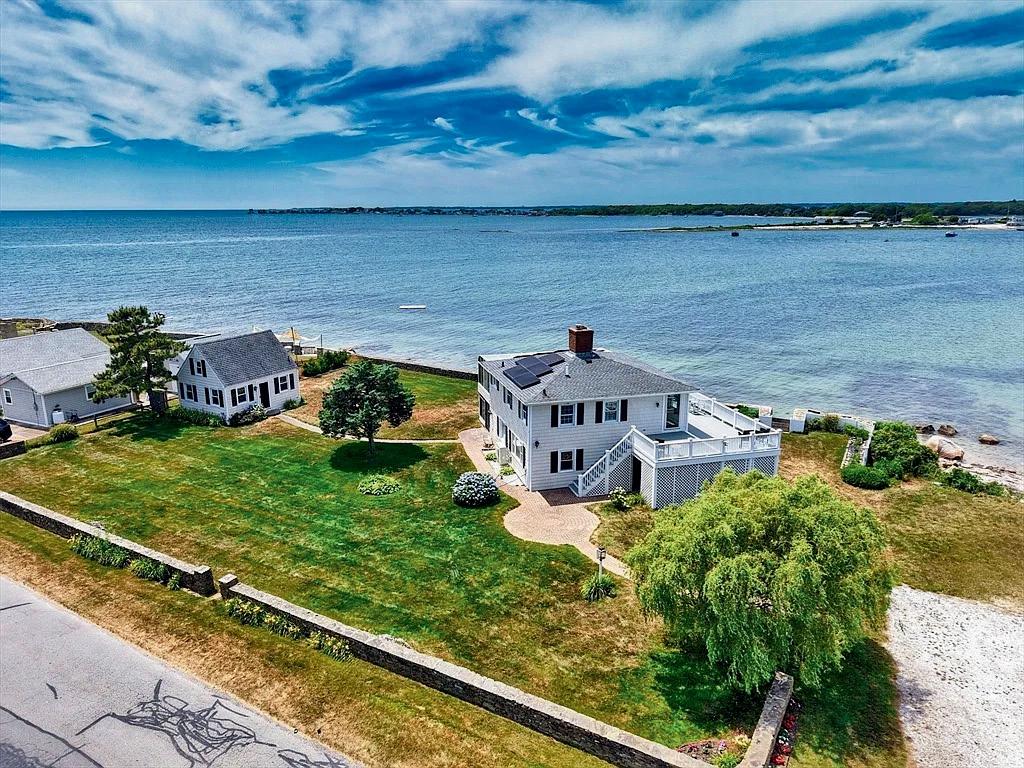
DETERMINED, TALENTED, & BEAUTIFUL, SHE SETS THE BAR TO MEASURE SUCCESS


DETERMINED, TALENTED, & BEAUTIFUL, SHE SETS THE BAR TO MEASURE SUCCESS


ROUND HILL - SEASIDE EAST $2,495,000
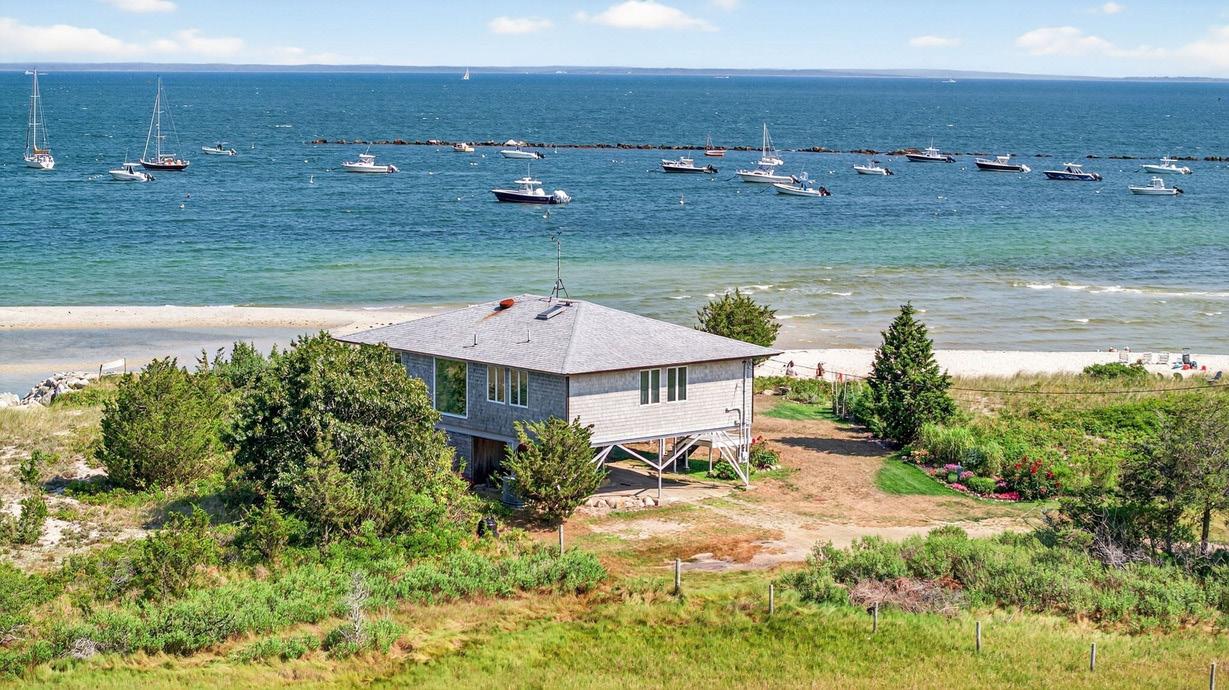
Rarely available! Direct waterfront, three-bedroom, two-bath home with private pathway to white, sandy beach. Amenities include beach, pool, tennis and golf. Contact Will Milbury 508.525.5200 or Sarah Meehan 508.685.8926
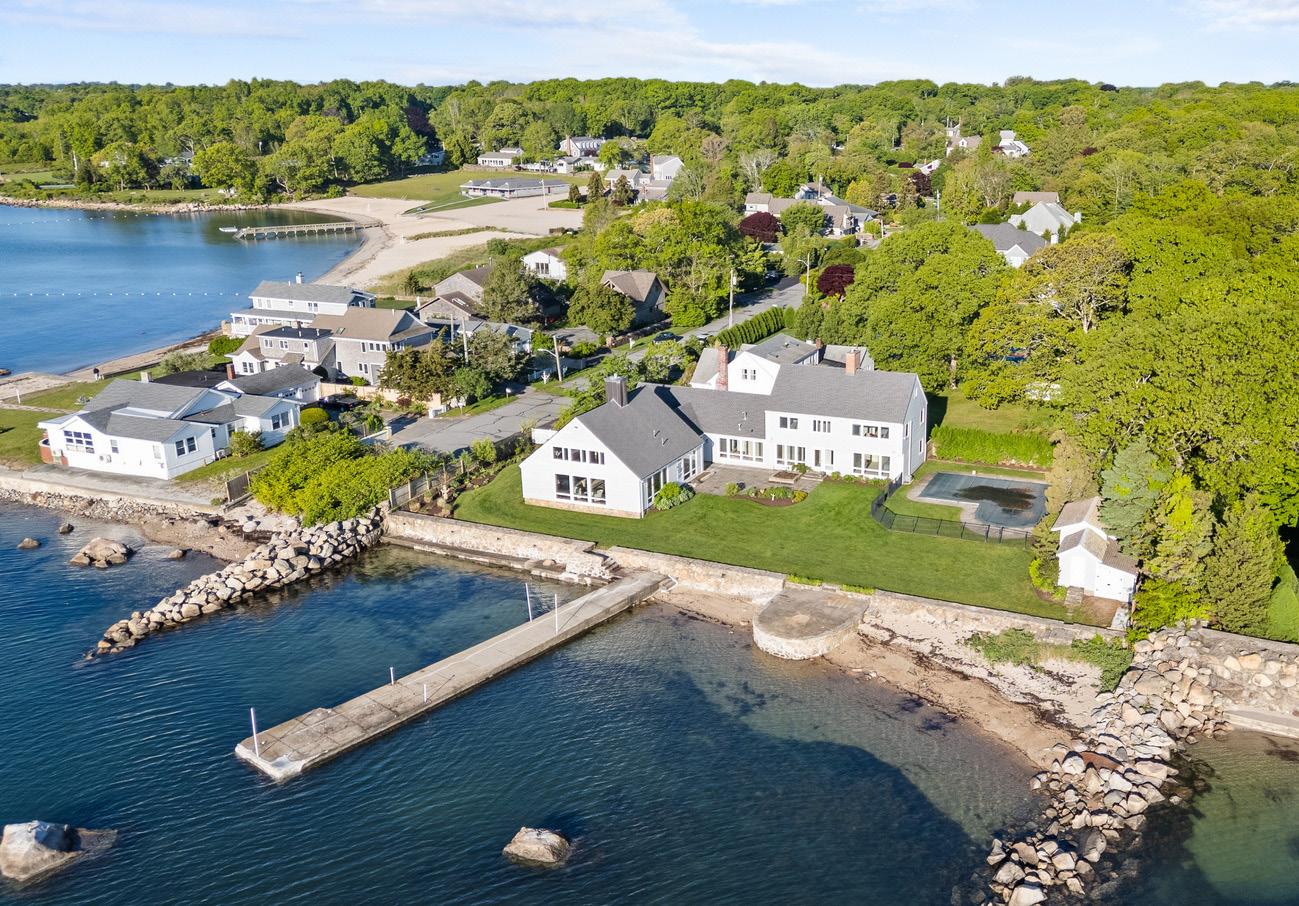
DARTMOUTH
$2,395,000

ROUND HILL - HETTY GREEN $1,999,000

Sensational contemporary Colonial on nearly an acre in the heart of Padanaram Village! A blend of formal and informal spaces offers French doors to terraces and park-like gardens, set just a stone’s throw from the Village! Contact Will Milbury at 508.525.5200.

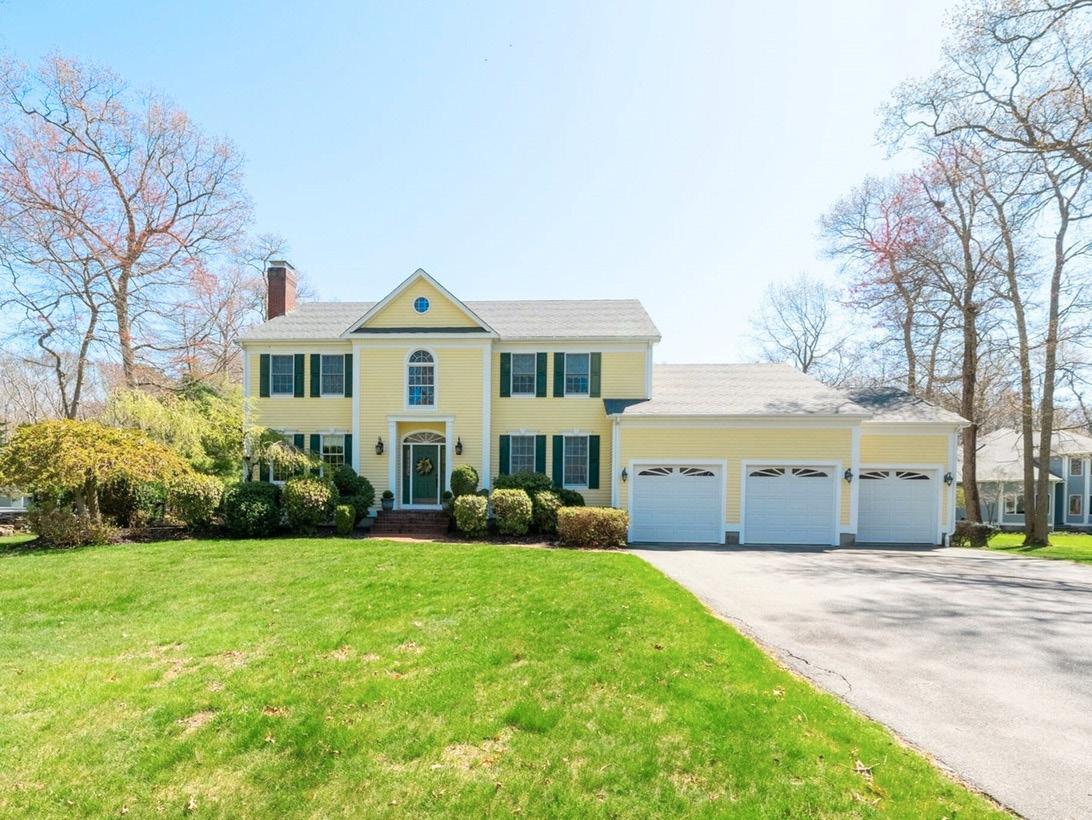

TIVERTON $1,075,000
Fogland Point! With breathtaking views of the Sakonnet and Aquidneck Island, this charming summer cottage is set on high and is comprised of two lots, totaling nearly three-quarters of an acre. Contact Kevin Quinn at 774.319.3401.

FAIRHAVEN $875,000
Set along the shores of Buzzard's Bay, this charming coastal cottage offers dramatic water views from ‘most every room. Minutes from Fort Phoenix, bike path, beaches and shopping. Contact Will Milbury at 508.525.5200.













































We have pressed this issue far beyond necessity. Through insights, examples, and repeated warnings—at times even pleading—we have laid bare the hidden agendas of power-hungry ideologues who reject reason and refuse compromise. Their influence undermines the rules of civility that hold society together. Yet the public, largely indifferent, shows little interest in advancing a culture rooted in safety, security, and mutual respect. The divergence of opinions and actions for managing or controlling those exhibiting relentless impulsiveness foreshadows darker consequences in the future.
The offensive modalities that exist in nearly every neighborhood, mode of transportation, and at public events are reprehensible; in most cases, the actions of an aggressive and wilding individual or group are implicitly illegal, usually immoral, and absolutely cruel. Yet these violent but tolerated offenders are obscured by convoluted theories based on uninformed and uneducated opinions rather than science, statistics, and personality research—data that clearly shows rehabilitation isn’t always failsafe, and long-term protections are sometimes necessary. Each day proves that countless disruptive individuals, like-minded tribes, and organizations, whether by choice or circumstance, cannot live peacefully in society and therefore endanger those who uphold responsibility and deserve protection. Nowhere is there a claim or the intention that the collective majority must endure personal sacrifices or face physical risks, so that the non-functioning or radicalized among us have free rein to invade or strip away our inalienable rights of peace and harmony.
At the same time, while the misguided create long-winded exemptions for offenders, thousands are processed into the criminal justice system, regulated by a metaphoric revolving door, which eventually releases depravity and violence upon those seeking a peaceful existence for themselves and their families.
We stand, caught between disorder and denial. For every ordinary citizen who wants nothing more than to live within reason and expectation, there seems to be a counterforce—a person or a policy—eager to excuse, to exempt, to erode standards that once served as the bedrock of public trust. We are told to be tolerant of behavior that undermines our safety, as if indulgence were a higher virtue than responsibility.
Politics, one might assume, would intervene. If not to solve,
WON’T IMPROVE, LEAVING US TO NAVIGATE AND ADJUST ACCORDINGLY
then at least to slow the degradation. Yet today, representatives have little concern for public safety; instead, they focus on accumulating raw power. Each side lays claim to moral superiority while citizens wonder if leaders genuinely care about their constituents and communities, and why they face daily evidence of decrepit conditions in our cities, violent outbursts in public settings, and declining trust in the authorities. The answer is unsettling but plain—your security is not the priority; the rationale of using words in place of actions is burdened by the fact that collateral damage will occur, and what matters is where limits are placed.
Results of past and recent studies are chilling; reputable researchers found the following in their investigation to weigh public opinion after the assassination of Charlie Kirk. Recent polling (self-reporting) underscores an alarming trend that indiscriminately violates the boundaries of a civil society. A Rutgers–NCRI survey this year found that more than half of left-of-center respondents believed it was at least somewhat justified to murder Donald Trump, with nearly 15 percent declaring it “completely justified.” Similar numbers approved violence against Elon Musk or even the destruction of private businesses like Tesla dealerships. This quantifiable data demonstrates a willingness to endorse brutality in the name of ideology. Still, such concentration for eliciting political change has a history. In 2017, only 8 percent of Democrats and Republicans alike admitted that violence might be justified to advance political goals. By 2020, that number had climbed into the 30 percent range for both parties. And in the latest YouGov poll -only days ago- following the murder of Charlie Kirk, more than 1 in 10 Americans openly said violence can sometimes be justified. Among Democrats and Independents, the numbers were even higher. This data is not an opinion but a scientific fact that gives insights into the mindset of those who endorse violence.
While majorities still oppose political assassination, the fact
that 10–40 percent of respondents across studies rationalize harm indicates a profound rupture in our social fabric. Even a small minority willing to cross an inconceivable line is enough to cause fear, panic, and chaos in the daily lives of American citizens. What is unforgivable is that these numbers indicate, culturally, we are failing those coming up and who will eventually take on the responsibility for the country’s future.
In a functioning society, such acceptance would be unthinkable. Today, it is disturbingly normalized—another reminder that compromise and civility have given way to the dangerous indulgence of extremism, and we have only ourselves to rely on for our protection and safety.
An obsession with dominance rather than duty explains why nothing improves. A society led by factions bent on scoring points rather than finding solutions will always flounder. Meanwhile, citizens are asked to shoulder the consequences: the exhaustion of navigating hostile environments, the fear of entering public spaces, and the erosion of confidence that civility will prevail over cruelty.
The middle ground, so often romanticized, is not elusive because it is invisible but because it requires maturity. Compromise demands adults at the table—individuals willing to concede a point for the greater good. Instead, what we see are selfserving postures masquerading as conviction. Each camp insists its way is the only way, while the pendulum of society swings violently back and forth, never pausing at equilibrium, never settling into peace.
If real change were possible within this framework, it would have arrived already. We have endured countless cycles of reform and reversal, campaigns built on promises of renewal, debates framed as turning points. Yet the decline continues, and the reason is simple: change cannot be achieved when too many insist on exemption from the rules. A functioning society is built not only on rights but on responsibilities. To demand freedom without accepting limits is to unravel the very conditions that make freedom possible.
Of course, no one wants suffocating control over their lives.

The instinct for liberty is natural and worthy. But there is a difference between liberty and license. To live in a community is to accept that some restraint is necessary—that order and accountability protect more than they restrict. Knowing that death and destruction can be curtailed, that safety can be reasonably assured, is not oppression but a small price to pay for the privilege of returning home each day to find one’s family secure.
What we endure instead is a steady erosion of that assurance. Aggressive individuals terrorize public spaces under the guise of expression. Lawmakers debate endlessly while neighborhoods fracture. Leaders invoke safety only when it suits political theater. And the public, tired and disillusioned, adjusts its expectations downward, learning to live with dysfunction that should never have been tolerated in the first place.
It is not naïve to believe society can do better. What is indefensible is to think it will happen without effort, accountability, and an absence of standards for ourselves and for those we empower.
The choice before us is not complicated, though it may be difficult. We can continue indulging the destructive few, permitting politics to remain a hollow contest of power, and resign ourselves to the daily degradation of civility, or we we can decide, as adults in a shared society, that rules matter, compromise is not surrender, and freedom must coexist with order.
The pendulum will never stop swinging; it is the nature of human affairs. But it need not leave us perpetually off balance. The point of satisfaction—the point where freedom and responsibility meet—is not unreachable; in fact, it is within our grasp, if only we choose to demand it.
Until then, we remain in motion, bracing against the next swing, adjusting as best we can to a divide that shows no signs of closing on its own. The question is whether we are willing to let it widen indefinitely, or insist on standards that ensure our safety a bright future. H
Enough is Enough. The evidence is overwhelming that humanity has not fully evolved from its primitive instincts. We must learn to discern the difference between the crude satisfaction of force and the cultivated standard of a civil society. The persistence of daily vitriol and violence—and the tolerance of criminals in our midst—makes one truth unavoidable: reliance on others for our safety is no guarantee. Preparedness is no longer optional; it is a duty to provision for contingencies and to guard ourselves against situational threats.

Teachable Moment. From epic battles on grass and clay to a joyful reunion at the Hall of Fame, it’s a story that shows how competition can spark greatness and friendship, and a reminder that humanity relies on the acceptance of rivalries ending with respect and celebration, rather than division.
Center Stage. Newport reigned over the world of tennis as athletes, stars, celebrities, and fans converged for the 2025 International Tennis Hall of Fame Induction. Against a backdrop of seaside charm and historic tradition, Maria Sharapova, the Bryan brothers, and Serena Williams drew global attention to a weekend that blended pageantry, legacy, and prestige.


Level Up. In an era where rudeness is excused as authenticity and taste is dismissed as subjective, civility feels endangered. We explore why refinement, restraint, and etiquette still matter, and how etiquette shapes not just appearances, but character. From family life to public spaces, rediscovering good taste offers more than polish; it’s a return to dignity and personal responsibility.

Living The Dream. Is newfound wealth burning a hole in your pocket? Considering a ski condo or beachfront escape for personal use and as an Airbnb rental investment?
Don’t rush, because there is a fine line between fantasy and reality when allocating millions of dollars to an investment that glitters! We take a serious look at the costs and perceived benefits of lifestyle investing over more traditional options.

Blame It On Dopamine. The same chemical that fueled human survival now drives Netflix binges, missed deadlines, and questionable browser histories during the evening. Discover the science (and irony) behind how our internal drives fuel bouts of procrastination, swiping, and pleasureseeking, while our brains simultaneously train us to maintain a loop of reward and reinforcement that keeps us chasing quick hits rather than long-term gains.
mRNA: Miracle or Misfire?
Once hailed as a “medical miracle” that would end the pandemic, mRNA vaccines are now under fire. Political reversals, scientific debate, and funding cuts have thrust this biotech breakthrough back into the spotlight. Flip the page to separate fact from fiction and see what the future holds for mRNA technology.

Give Your Best. If you see it here, you can be sure it’s worth your time. Explore and participate in the finest venues, travel options, and unique experiences, whether close to home or at distant destinations. From the coastline to the mountains, sometimes diving into the pulsating metro vibe of cities, you can be sure we’ll point you in the right direction.
A Toast To Silent Pool.
“Precisely Crafted In England,”they tell us. We share our impressions, after a private tasting at Boston’s famed restaurant, Contessa, high above Newbury Street.
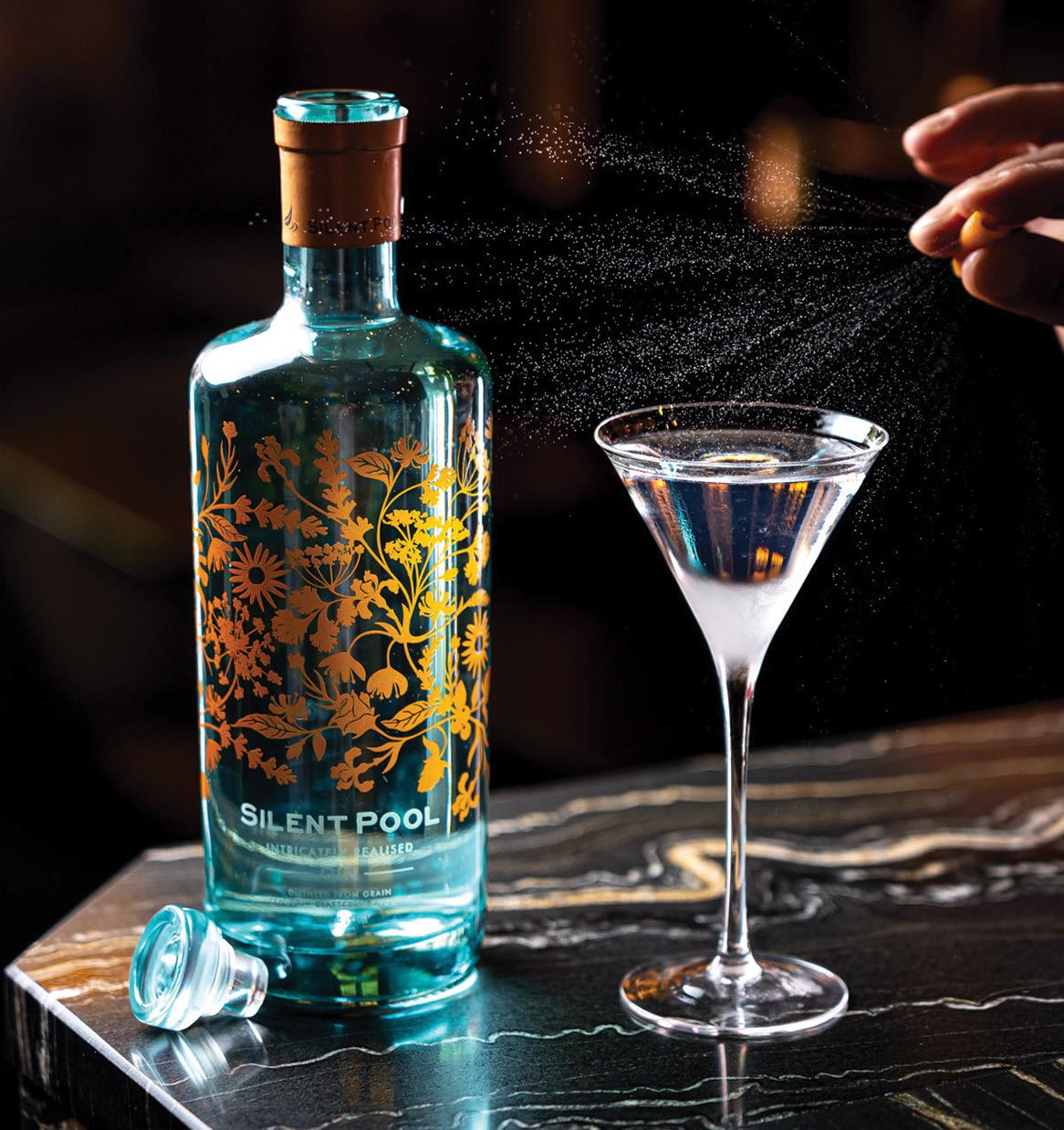


We can’t imagine who has the time to debate genes—unless, of course, you’re in publishing.
In our world, genes tell a complete story. From striking covers to thought-provoking articles that capture today’s culture and anticipate tomorrow’s challenges, it’s clear which publications possess the traits necessary to undertake such an ambitious journey.
Our family of magazines takes pride in a tradition of transparency and trust—qualities our readers expect and rely on month after month. For more than two decades, our editorial DNA has been on full display: designed for enjoyment, crafted to intrigue, and committed to sharing insights that engage an informed and astute audience.
At the same time, we are curators of entertainment. As publishers of ideas and opinions, we reflect the pulse of today’s culture while tracing the shifting contours of society over time. Our perspectives are delivered with clarity—never obscured by coded language or clever distractions. What you see and read is a carefully woven double helix of truth and relevance.
And best of all, you’ll never find yourself bored reading our pages.
Beyond looking polished, one thing is sure, we’re comfortable in our jeans.

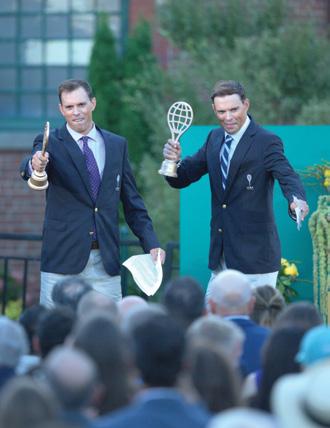

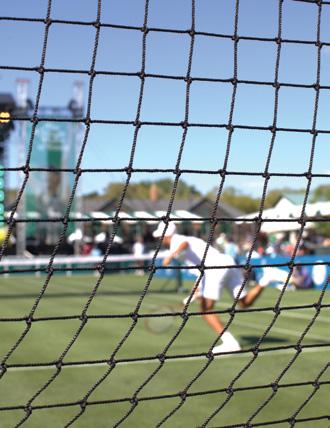
For exclusive advertising opportunities, contact us today at nemedia@earthlink.net or give us a call at 508-971-1969





BY PEET NOURJIAN
IN ANCIENT TIMES THE QUEEN HELD COURT TODAY A PRINCESS RULES THE SPORT OF WOMEN’S TENNIS, GRASS OR CLAY TWO LEGENDS HONORED FOR THEIR PLAY
SHARAPOVA AND SERENA AT THE HALL OF FAME ARENA BITTER RIVALS ACROSS THE NET FIERCE MATCHES WE CANNOT FORGET

NOW ARM IN ARM THEY CELEBRATE ADMITTING SOMETIMES IT WAS HATE SPARKING RACQUETS IN THEIR GRIP IGNITING A LIFELONG FRIENDSHIP
A LESSON WE SHOULD ALL EMBRACE COMPETITION WITHOUT A TRACE OF RACIAL DISCRIMINATION TO DISRUPT THE CELEBRATION. H

MARION $3,900,000
Stunning 5-bedroom contemporary situated on 4.5 acres with scenic views of Planting Island Cove. Easy access to Kittansett Golf Club as well as a rare opportunity to share in a spectacular boat house and dock.

DENNIS $3,200,000
Beautifully renovated antique in Dennis village blends timeless charm with modern luxury.

PEMBROKE $1,525,000
At the end of a cul-de-sac on 3.5+ acres, this spacious sanctuary offers shared dock access to the scenic North River.

PROVINCETOWN $2,495,000
Bathed in natural light, the open living areas feature soaring ceilings and walls of glass leading to an expansive deck.

SOMERVILLE $1,250,000
Two-family home in prime location on Prospect Hill above Union Square.

WESTPORT $1,600,000
Magnificent custom-built 12 room Georgian Colonial set on 6.76 wooded acres.

ACUSHNET $609,900
Beautifully updated, this ranch-style home offers a bright, open plan, large fenced-in yard and inviting in-ground pool.

EXCLUSIVELY LISTED AT $4,500,000
Step inside this classic 1961 Royal Barry Wills-designed Cape Cod-style home located in the heart of Marion Village! Set on a private .52 acre lot, this 2,400 +/- sq. ft. home offers 3 bedrooms, two of which are on the main level, three full, updated baths, a formal living room with Rumford fireplace and built-ins, dining area, cozy den, and a kitchen with updated appliances. Walk to the town center, Silvershell Beach, and schools in just minutes from this incredibly convenient, central location.
Custom-designed and built estate set on a 10+ acre estate in the secluded Hammett’s Cove neighborhood in East Marion. This property offers an unparalleled blend of elegance, privacy, and coastal charm. Complete with a 4,000 +/- sq. ft. main home, 3-car garage, gunite pool, pool house, putting green, and access to the association beach and dock, offering easy access to Sippican Harbor!

EXCLUSIVELY LISTED AT $1,375,000

EXCLUSIVELY LISTED AT $799,000
Rare opportunity to own a waterfront property with a private dock in the highly exclusive Allens Point neighborhood in East Mariom! This 2.4-acre lot offers a 2,600 sq. ft. home that can be revitalized or can serve as the site of your dream home. Incredible views of Blankenship Cove and Buzzards Bay!
Newly remodeled Cape Cod-style home in the seaside town of Marion. The first floor’s open layout features a chef’s kitchen, dining room with a fireplace, and living room—first floor primary bedroom with a newly added en-suite bathroom with walk-in shower. Two additional bedrooms located on the second floor share a luxurious full bath. Freshly landscaped 0.26-acre yard with a shed and parking for four cars. Conveniently located just steps from Silvershell Beach and Marion Village!

EXCLUSIVELY LISTED AT $2,350,000


BY STEVEN CHAN
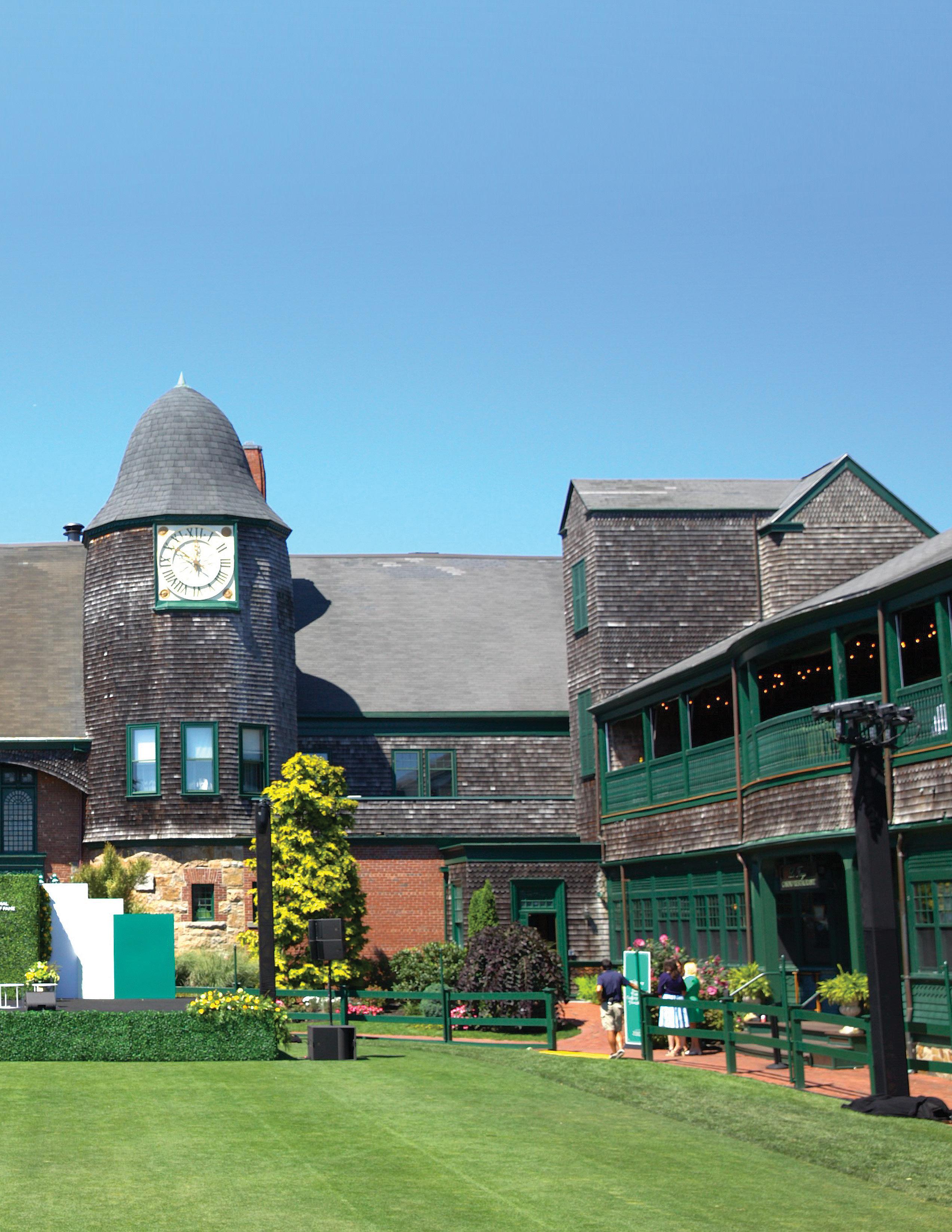
THE 2025 INTERNATIONAL TENNIS HALL OF FAME INDUCTION SURPASSES EXPECTATIONS

Some weekends pass quietly while others leave an indelible mark on both memory and history. This year’s International Tennis Hall of Fame Induction Celebration, held August 21—23 in Newport, Rhode Island, belonged firmly in the latter category. For three days, the ‘City by the Sea’ shimmered with anticipation, glamour, and reverence as the Hall welcomed its newest class: an elegant and sophisticated superstar of the sport, Maria Sharapova, and the indomitable doubles team of Bob and Mike Bryan. From the outset, it was clear this was no ordinary commemoration. The International Tennis Hall of Fame, housed in the historic Newport Casino, has long been a sanctuary of tradition, its lawns steeped in the earliest chapters of the sport. Yet this year’s induction seemed charged with something more—an electricity that ran through the conversations at cocktail receptions, the cheers at exhibition matches, and the eager faces lining the grounds. The occasion was not
merely to celebrate achievements in tennis; it was a gathering of legends, celebrities, and admirers drawn together to honor excellence in its purest form.
The first two days unfolded in a spirit of anticipation, blending heritage with spectacle. Guests meandered around the manicured grounds and courts, and through the recently renovated museum, now complete with interactive exhibits, a refreshed Hall of Famers Gallery, and a carefully curated collection of racquets, apparel, and artifacts that tell the sweeping


story of the game. Junior players stopped in awe before relics of past champions, while former greats, dressed in the signature Hall of Fame blazers, mingled with patrons and dignitaries. Conversations carried an air of nostalgia, punctuated by spontaneous laughter when old rivals crossed paths or shared memories from tour life.
Celebrity Pro Classics and friendly exhibitions added an air of pageantry. Fans cheered as retired stars partnered with actors, entertainers, and public figures in lighthearted doubles play. Beneath the

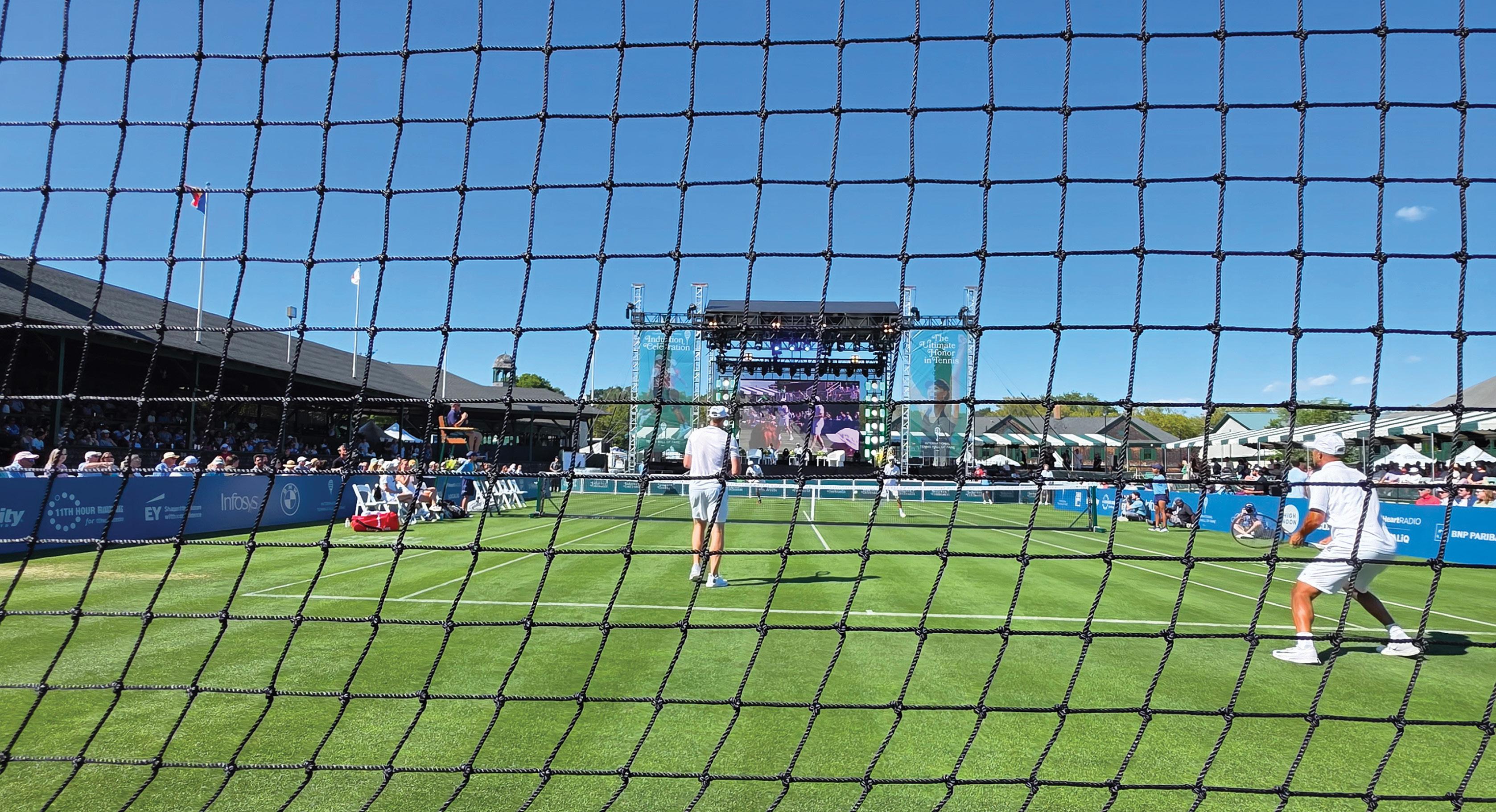
coastal sky, the event’s unique alchemy was on display: a setting where tennis history conversed with popular culture, where Newport’s timeless architecture provided a dignified backdrop to a festival-like celebration of sport.
By the time Saturday evening arrived, the sense of expectation had reached its zenith. The induction ceremony at Horseshoe Court drew a capacity audience, with standing-room-only crowds spilling into every vantage point. The evening air was heavy with summer humidity and the sound of gulls sweeping over the bay, but


the attention of the thousands present was fixed firmly on the stage.
The Bryan brothers were first to be honored. Together, Bob and Mike Bryan redefined what was possible in doubles tennis, amassing 16 grand slam titles, 119 ATP Tour trophies, and an Olympic gold medal. They ascended to the top of the rankings for a combined 438 weeks, their identical physiques and complementary skills creating a bond so seamless it seemed almost fated.
In their speeches, the Bryans reflected not only on triumphs but on the journey that carried them there. Mike Bryan, speaking with his usual warmth, said, “Doubles was our love from day one. We loved everything about doubles. We loved the strategy, the
teamwork, [and] sharing the highs and lows. Like our personalities, our games complemented each other perfectly.” His words captured what made their legacy distinctive: the joy they derived not from solitary conquest but from partnership.
Bob Bryan’s voice carried gratitude for the sacrifices made along the way. “There’s a lot of people that have sacrificed so much for us to be on the stage,” he acknowledged, before adding, “doing it with Mike the whole time, being able to share the ups and downs... made it that much more memorable.” For a sport often characterized by individualism, the Bryan brothers embodied something different: a model of family loyalty, mutual respect, and shared ambition.
Their induction was a celebration of collaboration, and yet it was the next moment that turned the evening into something unforgettable, even historic. When Serena Williams stepped onto the stage to introduce Maria Sharapova, the audience rose as one. Gasps and applause echoed across the court. Here, before the tennis world, one of the fiercest rivalries in modern sport was recast in the language of mutual admiration and respect.
Serena spoke with clarity and purpose: “There are only a few players in my career who challenged me to be the very best, every single time we stepped out on the
court. Maria Sharapova was one of them. Whenever I saw her name next to mine in the draw, I made sure I practiced harder.”
Her words hung in the air, a testament to how rivalry can forge greatness. Sharapova’s rise to global prominence had always been defined as much by her victories as by her battles with Williams. To hear Serena frame their encounters as a crucible of excellence was a moment of grace and recognition rarely witnessed in sports.
Sharapova’s reply, delivered in her induction speech, resonated with candor and humility. “It’s a gift to have someone who motivates you to reach those heights. And I’ll forever be grateful for bringing out the best in me,” she said. She described their encounters as contests of unrelenting will: “We both knew no other way than to fight our hearts out. We both hated to lose more than anything on this earth, and we both knew that the other was the biggest obstacle between ourselves and the trophy.”
It was not simply a speech of gratitude; it was a manifesto for ambition. Sharapova, so often characterized by intensity, revealed the resilience behind her legacy and the wisdom of perspective gained only in retrospect.
The audience included a dazzling array of past champions. Martina Navratilova, Stan Smith, Tracy Austin, Andy Roddick, Arantxa Sánchez Vicario, and many others were present, their familiar silhouettes cloaked in tradition. Navratilova praised the Bryan brothers with characteristic precision: “Not too many athletes transcend


Her voice carried conviction as she turned to address the broader meaning of her career. “In giving my life to tennis, tennis gave me a life. What a remarkable, remarkable life. And I’m so deeply grateful for it.” Later, she urged the next generation to resist complacency: “When voices inevitably tell you to ease up, to round your edges, dull your ambition, I hope you can find a way to ignore them. Compete fiercely. Raise your standard. Set goals that intimidate you. And don’t forget to celebrate your victories, no matter how small.”
their sport. For twins to do it is amazing.”
The evening’s solemnity gave way to festivity as the induction ceremonies concluded. On stadium court, the multiplatinum band Fitz and the Tantrums took the stage. Their performance infused the historic venue with rhythm and vitality, drawing the crowd into an exuberant celebration. For some, it was the first time they had danced beneath the Hall’s venerable spires; for others, it was a reminder that sport, like music, is meant to inspire joy and happiness.
By the close of the night, Newport had given its guests something lasting: a memory that transcended the pageantry of an awards ceremony. The weekend illuminated the essence of competition and recognition, of rivalry and reconciliation, of ambition and gratitude.
It underscored that legacy is not measured solely in trophies or statistics, but in the capacity to inspire, to elevate those around us, and to endure in the imagination of those who bear witness. Sharapova, the Bryan brothers, and the presence of Serena Williams had together created a tableau that will remain etched in the collective memory of the sport.
As the crowd dispersed into Newport’s streets, still humming with music and conversation, one could not help but sense that the past three days had been about more than tennis. It was a reminder that excellence, when celebrated with reverence and shared in community, resonates far beyond the confines of a court. H


Our most celebrated covers have never been won on beauty alone.
Time and again, the faces that grace our pages belong to individuals whose allure runs far deeper—those with intellect that inspires, achievements that impress, and stories that linger long after the page is turned.
This season, we invite contenders who embody a rarer kind of radiance: beauty intertwined with brilliance, ambition, originality, and a perspective shaped by remarkable experiences.
If you are elevating yourself, uplifting others, or carrying a tale of perseverance and triumph, we want to give your journey a voice.
Let us redefine beauty together—not as something merely seen, but something profoundly felt.
Farm, Fish, Or Raise Local Food Sources?
How About Creating Or Building With Sustainable or Renewable Products?
If you answer yes to any of these questions, we have a space for you.

We are committed to providing the exchange of ideas and products between manufacturers, gatherers, makers, and our readers. If you want to sell more products—hey, even locally sourced services, we’re offering a limited-time opportunity to promote your small business with rates that no one can match.
IN USA
To learn more, write to us about your company; we’d love to have you join us. NEMedia@earthlink.net


BY MARGO ROBERTS
It has become impossible to ignore: society is coarsening. From the daily irritations of running errands to the dreaded gauntlet of modern travel, our connections feel increasingly abrasive, stripped of the small courtesies that once softened human interactions. Politeness, once considered a baseline expectation, is too often replaced by rudeness or indifference. On the other hand, good taste, whether in manners, appearance, or expression, has become elusive.
The easy excuse often cited is that times have changed, that people today feel entitled to unfiltered self-expression or to whatever behavior secures their fleeting validation. Yet when aggressiveness replaces assertiveness, when volume is mistaken for confidence, we are left to wonder: are these really signs of progress, or symptoms of insecurity and cultural decline?
One need not look far to witness this erosion. Consider the once-common deferences of greeting a shopkeeper, respecting personal space in line, and dressing appropriately for an occasion; these are no longer reliably observed because they are not often practiced. Many now avoid public settings altogether or retreat into tightly controlled circles, weary of navigating a minefield of unchecked emotions and disregard for etiquette. Some believe this was, in part, the basis for the expansion in the home-delivery service industry, which seems to propagate exponentially.
Underlying this decline is a troubling belief—that one’s personal experiences or feelings alone determine acceptable conduct. Instead of appealing to broader standards of discipline, civility, or refinement, many justify poor behavior as a personal right. But authenticity without responsibility quickly veers into selfishness.

For some time, we’ve witnessed technology accelerate this unraveling. The media diet of millions is dominated by personalities who thrive on spectacle: influencers who elevate outrage, exhibitionism, or conspicuous consumption into a profession. In this climate, vulgarity is not only tolerated but monetized. The few who profit reinforce a dangerous liaison— attention: no matter how it is earned, is equivalent to worth or personal value perceived.
Contrast this with earlier generations of wealth and influence. True refinement was once expressed subtly, through quiet philanthropy, careful manners, or the disciplined stewardship of family traditions. The emphasis was on legacy and responsibility rather than self-promotion. Today’s culture often rewards the opposite: pretenders who imitate heritage, flaunt possessions, or manufacture drama as proof of relevance.
Andy Warhol’s famous prediction that everyone would have “15 minutes of fame” has metastasized, and for all too many, their identities depend on constant exposure superfluous acknowledgment, and unconditional acceptance. In this race to be seen, substance is too often discarded for face time, and twisted truths.
The erosion extends into family life. Marriage and child-rearing are increasingly delayed or abandoned, divorce remains high, and relationships are often approached as disposable. A “hook-up culture” celebrates temporary pleasure while leaving emotional exhaustion in its wake. Men and women alike report rising levels of depression, disconnection, and what some psychologists call “mo od dysphoria”—the gnawing sense of failure in partnership. When family bonds weaken, the structures that once transmitted values of responsibility, courtesy, and restraint falter as well. Whereas elders once modeled self-discipline and shared traditions, many now prioritize convenience or self-interest. Children grow up without the reinforcement of etiquette, charm, or grace—and are left to imitate whatever the broader culture parades before them.
Perhaps the most damaging shift is the steady retreat from personal responsibility. Increasingly, problems are framed as someone else’s fault—institutions, systems, or circumstances bear the blame. While structural injustices do exist, an overreliance on external explanations fosters entitlement and weakens moral character. Without accountability, chaos spreads. Minor lapses, ignoring commitments, neglecting civility, and excusing rudeness compound into larger fractures of trust. In extreme cases, unchecked resentment erupts into violence, and as we have all witnessed, accidental and intentional loss of life. The foundation of social order is not law alone but the daily practice of selfrestraint, respect, and accountability, much of which has been given a pass because of trauma decades prior.
At this point, one might ask: what does “good taste” have to do with this narrative? Isn’t taste merely subjective, a matter of preference? History suggests otherwise. From Versailles to modern design homes and public spaces, taste has always been more than

Five timeless qualities illustrate the heart of good taste and social refinement:
Restraint Over Excess – True elegance lies in editing, in knowing when enough is enough
Harmony of Proportion – Whether in a room, an outfit, or a conversation, balance creates a sense of beauty
Confidence in Simplicity – One well-chosen object or phrase carries more power than a dozen mismatched ones
Respect for Craft – From handmade shoes to carefully written words, appreciation for skill honors human dignity
A Sense of Appropriateness – To adapt one’s behavior to time and place is not repression but respect
These qualities apply as much to behavior as to design. A gracious word, a thoughtful pause, or a modest gesture can elevate a situation more than any display of wealth or force.

aesthetics. It reflects discernment, restraint, and the ability to elevate the common good above personal indulgence.
In many ways, our personalities resemble art, music, or architecture. They can be shaped with harmony, proportion, and care, or left to collapse into noise and disorder. Offensiveness, disregard for quality, or settling for “just enough” are the social equivalent of bad design: easy to produce, but unpleasant to live with. By contrast, refinement—whether in manners, speech, or personal style—requires effort and discipline. Creation always demands more energy than destruction, yet the results endure and inspire.
Good taste is not simply the ability to purchase the extraordinary or rare; it has much to do with an assemblage of knowledge and acuity in design; it entails the development of a concept or idea into a finished work or a well-defined personality. A mansion plastered in gold may convey wealth, but rarely refinement. Unrelenting boasting displays low emotional intelligence and, admittedly, an omission of intellectual artifact.
The validity of good taste or refinement is often revealed in what is left out—the restraint to edit, the discipline to choose harmony over clutter, subtlety over excess. It is the same principle that guides etiquette: knowing what behavior elevates the moment rather than diminishes it.
Some are born with a natural eye for proportion and beauty, but these attributes can also be cultivated. Exposure to art, music, architecture, and diverse cultures sharpens discernment. Mentorship—whether from family, teachers, or professionals— imparts the values of restraint and appropriateness. Travel, too, reveals the variety of expression: Kyoto’s quiet minimalism contrasts with Palermo’s exuberance, yet both teach lessons in refinement.
Cultivation requires effort. It is a practice, not a possession. Like a muscle, taste develops through repeated engagement with excellence and reflection on one’s own choices.
Taste and refinement also carry a moral dimension. To prefer craftsmanship over disposability, to value sustainability over exploitation, is to align beauty with responsibility. In this way, discernment becomes more than a matter of style—it becomes a reflection of character.
This perspective offers a remedy to both society’s decline and social skill enhancement. If we reframe acceptable behavior not as an extension of personal history or grievance, but as part of a lifelong process of growth, we reclaim agency. Rather than excusing misconduct as normalized, we can measure ourselves against higher expectations: civility, accountability, and the cultivation of responsibility.
Not all is lost. Despite cultural decline, many young people consciously reject the loud and the shallow, choosing instead to cultivate grace, discipline, and taste. They are rarely noticed— overlooked by the self-centered, too distracted to care, or dismissed by those who feel oddly threatened by a quiet demeanor or suspecting another’s next move because they don’t know what their own might be. It’s understandable that they unintentionally pose a threat to the ‘posers’ who have little to share other than a warped perspective of their value and contributions.
The lesson for all of us is clear: organizing our lives solely on personal history—the hurts, entitlement, and desires—leads to stagnation. Organizing social behavior within the spectrum of personal growth, refinement, and higher expectation invites progress. It is a practice available to anyone willing to learn, to reflect, and to hold themselves accountable.
Ultimately, good taste is not about judgment, but about personal aspiration. It is a way of honoring others by improving ourselves— of resisting decline not with condemnation, but by example. Society may be coarsening, but individuals who cultivate civility, refinement, and responsibility quietly keep alive the possibility of something better in the future. H


Dopamine, often oversimplified as the “pleasure chemical,” is more accurately understood as the driver of anticipation, motivation, and the pursuit of reward. It does not simply make us feel good when we achieve a goal; rather, it energizes our behavior in anticipation of a potential reward, nudging us to act even before satisfaction occurs.
BY STEVEN CHAN
Hypersexuality and procrastination may appear unrelated at first glance, yet both are deeply intertwined with the way dopamine operates within our brains. Dopamine, often oversimplified as the “pleasure chemical,” is more accurately understood as the driver of anticipation, motivation, and the pursuit of reward. It does not simply make us feel good when we achieve a goal; rather, it energizes our behavior in anticipation of a potential reward, nudging us to act even before satisfaction occurs. This neurotransmitter prompts us to seek novelty, excitement, and immediate gratification, and it has played a critical evolutionary role in encouraging humans to explore, take risks, and survive. In today’s environment, however, the very mechanisms that once enhanced our survival can become a double-edged sword. When overstimulated by constant digital novelty, endless online content, and instant access to sexual cues, dopamine can drive behavior that undermines long-term goals, leading to patterns of compulsive hypersexuality or chronic procrastination. Scientific research has increasingly documented these effects, showing that repeated overstimulation can desensitize reward pathways, making ordinary achievements feel dull, uninteresting, or even stressful. At the same time, the brain continually craves more intense or immediate stimuli to achieve the same sense of motivation.
Consider procrastination. You might sit at your desk with a looming deadline, fully aware of the importance of completing the task before you. Yet, instead of diving into the work, you find yourself reaching for your phone, browsing social media, checking news headlines, or suddenly convincing yourself that you need a snack, a cup of coffee, or to review your investments. These diversions are not simply
signs of laziness or poor time management; they are the hijacking of dopamine pathways, a neurological preference for short-term reward over long-term benefit. The brain instinctively resists the discomfort, tension, or perceived difficulty associated with meaningful effort, seeking instead smaller, instantly rewarding activities that are far less demanding. Each avoidance provides a tiny spike of dopamine, reinforcing the pattern, yet leaving those who succumb to it with feelings of guilt, frustration, and self-reproach. Over time, this cycle can intensify, as repeated procrastination strengthens the brain’s preference for immediate gratification, creating a feedback loop in which even tasks that once inspired motivation now feel overwhelming or insurmountable. The more the brain is trained to seek instant reward, the more difficult it becomes to sustain focus, follow through, or derive satisfaction from longer-term achievements, creating a subtle but persistent erosion of productivity, confidence, and self-efficacy.
What makes both hypersexuality and procrastination destructive is not only the cycle of indulgence but the shame and stagnation that follow. Student subjects have described
the crushing weight of procrastination when they spend nights scrolling aimlessly, postponing critical research, and then spiral into guilt. Their paralysis worsened as the pressure mounted. These same subjects admitted that pornography had become another escape, compounding the inability to engage with reality, a distortion readily available. These tales reflect what many silently endure, as dopamine-driven distractions mask more profound anxieties and insecurities.1
To understand why this cycle feels so inescapable, one must grasp how dopamine drives not only desire but also reinforcement. Every time an individual procrastinates or engages in hypersexual behavior, the brain encodes that choice as rewarding, making it easier to repeat. It ostensibly explains why, despite rational awareness of the harm, people continue to seek the fleeting relief of avoidance or indulgence.
The irony is that dopamine is also essential for productivity and fulfillment. It fuels focus, ambition, and creativity when harnessed toward meaningful goals. The difference lies in whether it is directed toward short-term relief or long-term reward. As Steel (2010) noted in The Procrastination Equation, procrastination

“Exercise, mindfulness, and structured routines can recalibrate the brain’s reward system. Physical activity, for example, not only boosts dopamine but also promotes receptor sensitivity, helping individuals find satisfaction in nondestructive pursuits.”
thrives when tasks feel unpleasant or abstract, leading the brain to prioritize immediate gratification over delayed benefit. Hypersexuality operates similarly, offering a quick escape from stress or boredom at the expense of deeper satisfaction. 2
Life offers countless illustrations; a successful entrepreneur confesses that his greatest challenge was not business risk but self-sabotage.
Compulsive behavior, longer distraction, hypersexuality
Avoidance/ Procrastination
Tasks postponed,
Describing compulsive sexual behavior that left him exhausted, unable to concentrate, and fearful of exposure, his procrastination on critical projects grew worse as his secret habits drained energy and confidence. His financial success served as a mask for which he hid behind a personal crisis rooted in a dopamine imbalance. His recovery began not with willpower alone but by reshaping his environment, setting boundaries, and learning to tolerate discomfort without rushing to escape it.3
Ordinary tasks feel dull, reduced motivation

Pornography, social media, notifications, or minor
These stories underscore an essential truth: hypersexuality and procrastination are not moral failings but maladaptive responses to dopamine-driven impulses. By reframing them as brain-based struggles, rather than personal weaknesses, individuals can approach solutions with greater clarity and compassion.
One practical approach is to regulate dopamine through lifestyle changes. Exercise, mindfulness, and structured routines can recalibrate the brain’s reward system. Physical activity, for example, not only boosts dopamine but also promotes receptor sensitivity, helping individuals find satisfaction in non-destructive pursuits.4 Mindfulness meditation reduces reactivity to cravings, allowing space between impulse and action.
Another critical strategy involves breaking tasks into smaller steps; this approach reduces the brain’s perception of threat and provides incremental dopamine rewards for progress. Rather than waiting for motivation to strike, it begins with a modest, achievable action that creates momentum. Over time, this intervention retrains the brain to link productivity with reward. For hypersexuality, therapeutic interventions such as cognitivebehavioral therapy (CBT) and accountability structures can be transformative. By identifying triggers, restructuring thought patterns, and building healthier coping mechanisms, individuals can shift dopamine’s pull from destructive cycles to constructive behaviors.5 Reid et al. (2012) observed that successful treatment often involves not suppression of desire but redirection of energy toward meaningful relationships and purpose.
Temporary satisfaction, escape, or pleasure
Ultimately, the goal is not to eliminate dopamine’s influence but to align it with values and aspirations. Both hypersexuality and procrastination reveal how easily humans can be enslaved by the brain’s reward system when left unchecked. Yet they also highlight the capacity for growth when awareness and discipline replace avoidance.
Brain releases dopamine in anticipation of reward
Dopamine is not the enemy. It is the fuel of ambition, capable of driving creativity, intimacy, and achievement. But without conscious monitoring, it can become a force of distraction.
Recognizing the role of hypersexuality and procrastination in this process allows for a more compassionate and effective response, one that acknowledges the brain’s wiring while insisting on personal responsibility.
The modern world, saturated with instant gratification, makes this challenge especially urgent. From the endless scroll of digital platforms to the easy availability of explicit content, the temptations to overstimulate dopamine pathways are everywhere. To reclaim focus, intimacy, and purpose requires resisting the quick fix and embracing the slower, richer rewards of patience, effort, and genuine connection.
The student mentioned earlier reflected after months of therapy and intentional practice, “I learned that the discomfort I was avoiding was the very thing I needed to face. Once I stopped running from it, I started to find real progress.” His words capture the essence of overcoming both hypersexuality and procrastination: a willingness to tolerate unease in pursuit of deeper fulfillment.
By confronting these challenges with honesty, structure, and support, individuals can free themselves from cycles of temporary relief and embrace the lasting satisfaction of growth. In doing so, they transform dopamine from a master of distraction into an ally of purpose. H
1. Voon, V., Mole, T. B., Banca, P., Porter, L., Morris, L., Mitchell, S., ... & Irvine, M. (2014). Neural correlates of sexual cue reactivity in individuals with and without compulsive sexual behaviors. PLoS One, 9 (7), e102419.
2.3. Steel, P. (2010). The Procrastination Equation: How to Stop Putting Things Off and Start Getting Things Done. Harper.
4. Robertson, C. L., Ishibashi, K., Mandelkern, M. A., Brown, A. K., Ghahremani, D. G., Sabb, F., & London, E. D. (2016). Striatal D2/D3 receptor availability and motivation for exercise in humans. Translational Psychiatry, 6(3), e829.
5. Reid, R. C., Garos, S., & Carpenter, B. N. (2012). Reliability, validity, and psychometric development of the Hypersexual Behavior Inventory in an outpatient sample of men. Journal of Sex & Marital Therapy, 38(4), 335–349.
WHAT
BY STEVEN CHAN
Awindfall on a hot tip, an unexpected inheritance, the conditions of your trust fund just fell into your lap. Or maybe it’s a gift from your family so that tax implications can be reduced when filing for 2025. It doesn’t matter the reason for investing with the newfound wealth, as much as it is determined by the outcome of its intended consequences, which is primarily to compound principal over generations, rather than a spending spree on fun and entertainment; But to each their own!
Today, many high-net-worth individuals and families are holding between $3 and $5 million in deployable capital. The list of tempting investments is vast, ranging from Bitcoin, equities, bonds, and Treasuries to Private Equity and a growing trend toward Venture Capital acquisitions. But beyond these sedentary allocations, the dream of the extended family banding together to enjoy the winter holidays or summering at a resort community for the next 10-plus years is romantic and seems to make perfect sense. And if you combined this fantasy with the assumption that you’ll find others more than willing to contribute to ‘your’ cause, then perhaps owning vacation real estate is in your future.
Most importantly, when considering your next move, here’s an interesting caveat, a question every prudent investor must ask: Is my decision based on a fantasy or surrounded by reality?
Being an adventurous yet lulling belief that your new mountain-top home or oceanfront property can be utilized and maintained through a rental schedule, even though both are dependent on seasonality and bookings, brings significant risk; there are numerous seen and unseen variables lurking out of sight, waiting to pounce.
Another factor often overlooked is the potential for a dramatic fiscal downturn due to weather and climate change, even with the best-laid plans. And in hindsight, there are plenty of luxurious lifestyle campers who have learned a hard truth: even though you may believe you’ll share your vacation home for the added rental income, both you as an owner and the imaginary renters are going to want the premier dates, leaving weeks of emptiness and negative cash flow. Additionally, when considering when units
are typically available for owner use, it is often midweek, from Tuesday to Wednesday for weekly rentals, and during the ‘off-season’ for long-term rentals—none of which are optimal. As for holidays and vacation weeks, sorry, you might want to book a trip elsewhere, considering your place will be enjoyed by strangers.
The truth is, tourists and resort real estate often deliver disappointing outcomes and poor financial performance when weighed against more traditional investment classes. Based on this view and backed by a plethora of evidence, we examine the bestcase scenarios of vacation property ownership, the inherent risks, and how they compare with alternative investments.
When people imagine investing in real estate, they often picture a tangible, personal benefit: a home or condo on the slopes in New England, which is in overdrive with the development of on-mountain, ski-in/ski-out accommodations that are widely different from those found out West. As for Cape Cod, Nantucket, Martha’s Vineyard, and The Hamptons, or Florida, the variations can be dramatically skewed, and further research is necessary.
The benefits of these luxury properties can serve dual purposes; they can be viewed as an acceptable expense, discounted as a second or third home, with the thought of profit removed from the decision. At worst, the home or condo will eventually be offloaded, likely with a profit, which will possibly offset the carrying costs of the many years of family entertainment and enjoyment. For others, who don’t mind sharing, some rental income can provide assistance in paying taxes and other overhead with an eye on long-term appreciation of the property.
However, many ski towns in the Northeast are filled with new and ambitious homeowners who bought on speculation and are now frightened because they took on mortgages they couldn’t afford without the guarantee of solid winter rentals. More than a few are frantic by changes in condominium restrictions that were vague until non-renters within their developments witnessed the pains of ‘outsiders’ treating their surrounding properties like hotels and, in some cases, ‘flop-houses.’
Let’s look at the realities behind the dream.

Imagine purchasing a five-bedroom home or condo for $3 million at one of the many expanding winter resort communities in New England. In our analysis, we found a suggested average nightly stay to be approximately $600-$800, which to us seemed low. In fairness, we adjusted nightly rental rates, figuring they would command $1,500-$2,000. We base our numbers on total winter snowfall averaging across Maine, New Hampshire, and Vermont, and estimated that a new homeowner could expect to rent their newly acquired rental property for 40-50 nights per ski season.
Gross Rental Revenue: $60,000-$100,000
Operating Costs: $88,000-$90,000 (HOA, taxes, insurance, cleaning, maintenance, reserves)
Net Cash Flow: Negative $10,000-$40,000 per year (all-cash) Add financing, and the loss balloon could potentially be as high as $170,000 or more annually
Key Takeaway: Even in best-case scenarios, luxury ski condos don’t break even without exceptionally high occupancy (80-100 nights per year) or year-round rental demand. You’ll make this investment to keep smiles on family faces for the limited season you’ll be using your unit; don’t expect any income potential.


Now consider a $3.5-$5 million oceanfront home or condo from our list of possibilities—if you can find one at this price. Rental rates may hit $1,000-$5000 per night, and seasonal demand runs 12-16 weeks at peak.
Gross Rental Revenue: $84,000-$560,000
Based on the rental rates and seasonal demand
n Minimum Revenue:
$1,000/night × 12 weeks/year × 7 nights/week = $84,000
n Maximum Revenue:
$5,000/night × 16 weeks/year × 7 nights/week = $560,000
For exceptional properties, the gross will substantially increase, but again, it’s a rental, eliminating owner-occupancy
Operating Costs: $100,000+ (condo fees, taxes, and a substantial mortgage
Net Cash Flow: Slim margins at best; more often break-even or slightly negative. Hurricanes, flooding, and storm insurance also increase volatility, further eroding returns
Key Takeaway: If you want those winter smiles to linger, you won’t be renting; you’ll own it and be entirely responsible for carrying costs.

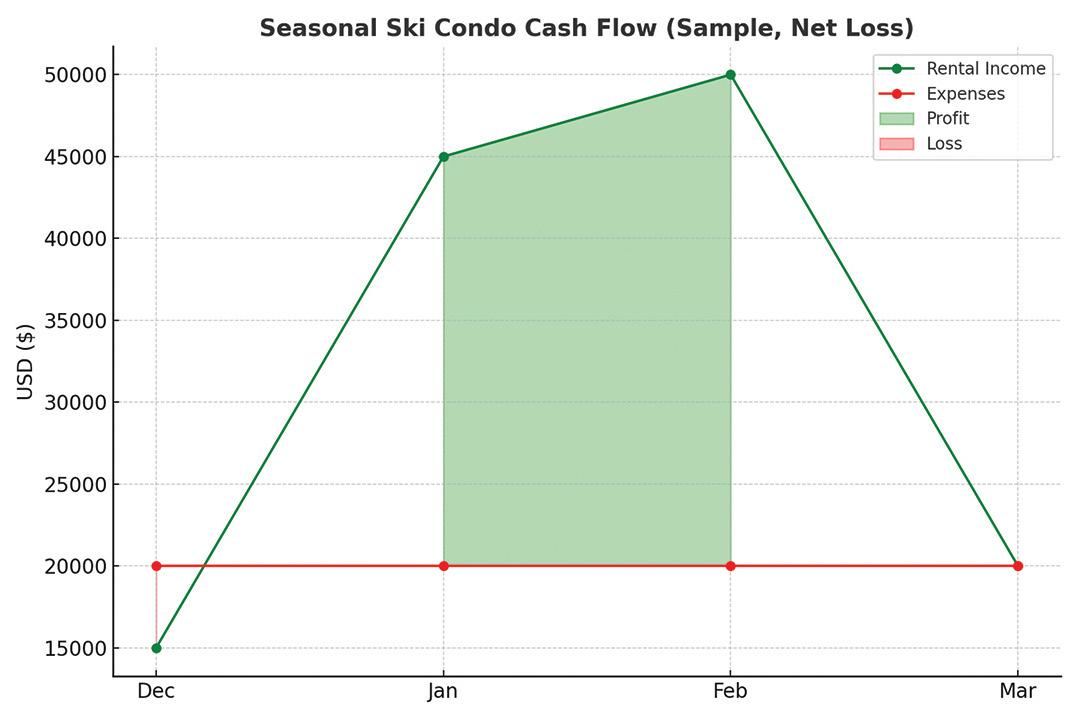
WHAT MAKES TOURIST PROPERTIES RISKY?
Primarily, unless you’re financially comfortable with seasonality and uncertain levels of occupancy limited to peak months, leaving units vacant most of the year, these are not as much investments as they are vacation homes. They come with extravagantly high fixed costs, including property taxes, HOA fees, security, and maintenance, which are paid annually.
Weather Dependence: Snowfall, hurricanes, and climate change, geopolitical events, all add risk, as well as illiquidity; selling a $3-$5 million luxury home or condo can take time and effort.
Economic Sensitivity: Luxury rentals are the first expense cut in a down-trending economy.
ALTERNATIVE INVESTMENTS
For the same $3-$5 million, here’s how other asset classes compare: PUBLIC EQUITIES
Expected Returns: 7-10% annually. (Something to consider, since January 2024 to September 15, 2025, market index returns have been approximately 38.69%.
Liquidity: High
Risks: Market volatility, geopolitical shocks
REITS (REAL ESTATE INVESTMENT TRUSTS)
Expected Returns: 6-9%
Liquidity: High (publicly traded)
Risks: Sensitive to interest rate changes, sector performance
RESIDENTIAL REAL ESTATE (NON-TOURIST)
Expected Returns: 7-11% with the possibility of appreciation over time, but not guaranteed
Liquidity: Medium
Risks: Tenant turnover, local market shifts
COMMERCIAL REAL ESTATE
Expected Returns: 6-10% with the possibility of appreciation over time, but not guaranteed
Liquidity: Medium to low
Risks: Tenant concentration, remote work trend, retail decline
TREASURIES / BONDS
Expected Returns: 3-5%
Liquidity: Very high
Risks: Inflation, limited upside

RANK ORDER OF INVESTMENT OPTIONS
(from strongest to weakest averages)
Public Equities (7-10% with even greater potential with risk)—
Diversified, liquid, historically strong returns
REITs (6-9%) —Real estate exposure without illiquidity
Residential Real Estate (7-11%) —Income + appreciation, less seasonal risk
Commercial Real Estate (6-10%) —Solid in selective markets, but complex
Treasuries (3-5%)— Stability and safety, limited growth
Vacation Properties (All Cash) —A lifestyle dividend with a negative to break-even cash flow
Vacation Properties (Financed)— Negative returns, amplified risk
LIFESTYLE VS. LOGIC
With these glaring numbers, why, then, do so many pursue ski and beachfront properties? Primarily, it’s due to lifestyle value in the placement of financial logic. For some investors, the return isn’t about yield but about creating family memories and owning a tangible asset that reflects success. The economic losses are accepted as the price of enjoyment; they follow the adage, “You pay to play.” H
References:
Money.com, Mortgage Rates (2025)
TheMortgageReports.com, Investment Property Loan Data
SelectCommercial.com, CRE Loan Trends Airbnb.com, Loon Mountain & Cape Cod Luxury Rental Listings Cozycozy.com, Market Comparisons for Tourist Rentals
Town of Lincoln, NH Property Tax Data (2024)
NSAA / AirDNA, Ski Tourism and Short-Term Rental Demand
(This information is exclusively for entertainment purposes and is not to be considered financial advice, nor is it a solicitation to purchase property or enter into any of the investments listed. Please consult your personal adviser to address your financial inquiries.)










Are you facing the challenges of caring for a loved one at home? Perhaps trying to wholeheartedly balance their needs and the daily demands life delivers you?
If this sounds familiar, we are here to assist you in providing an unmatched standard of Adult Foster Care benefits for those striving to stay in their homes.
Mass Care Link is evolutionary, providing a monthly payment to those caring for someone at home while supporting them with a personalized touch.
Costing less than assisted living facilities and nursing homes, with a record of compassion and empathy, we cover the unique needs of our clients.
Families and individuals rely on our services to:
• Ensure caregivers receive a tax-free monthly stipend/payment
• Review and verify MassHealth paperwork and qualifications
• Train and assist with the management and demand of providing 24-hour care
You may not know this fact, but if you qualify as an at-home caregiver, you can earn up to $18,240 yearly.
For a caregiver to meet state requirements, they must:
• Be at least 18 years of age
• Reside in the same home as the person they care for
• Not be the legal guardian or legally married to the person being cared for
• Provide necessary medical care and assistance that meets the needs of the person they care for
For your family member or loved one to qualify for Mass Care Link services, they must meet these eligibility points:
• Be 16 years of age or older
• Be approved for MassHealth insurance
• Live with the primary caregiver in the same home
• Require supervision and cueing, or physical assistance daily with at least one of the following needs: bathing, toileting, ambulation, transferring, eating, and/or dressing.
If this sounds attractive and meets your level of interest, contact us today for additional information or to schedule an appointment.
Mass Care Link, Inc.
99 South Main Street, Fall River, Massachusetts 02721 Hablamos Español | Falamos Português call for more information or visit us online at:
BY ROB SAINT LAURENT, M.ED.
Through Operation Warp Speed, the first Trump Administration propelled mRNA technology into the public consciousness at the height of the COVID-19 pandemic.
Said the President in December 2020, “This is one of the greatest scientific accomplishments in history. It will save millions of lives and soon end the pandemic once and for all.”1
Since that time, an estimated several billion people worldwide have received at least one mRNA vaccine dose, and the tech appears to be the next big step in biomedicine.
Ironically, mRNA has now come under fire during Trump 2.0, raising eyebrows and questions among scientists across the nation. What was dubbed a “medical miracle” by Trump just five years ago has now come under intense scrutiny by his Health and Human Services (HHS) Secretary, Robert F. Kennedy Jr.
The unexpected reversal highlights the technology’s controversial nature, with a stark division between supporters and critics of mRNA.
DNA, or deoxyribonucleic acid, is the genetic material inside the cell nucleus that contains a person’s unique blueprint for building and maintaining their body. To act on this blueprint, specific genes from one’s DNA are copied into
mRNA, or messenger ribonucleic acid, that delivers the genetic instructions to the cell’s ribosomes. Ribosomes read the mRNA sequence to make proteins that carry out vital cellular functions, like fighting disease and tissue repair. Researchers discovered mRNA in the 1960s and soon after began experimenting with mRNA and fat-based delivery systems. In 1987, Robert Malone performed a groundbreaking experiment in which strands of synthetic mRNA were enveloped in specially designed, round fatty structures called liposomes. When human cells were added to the cocktail, the cells absorbed the mRNA and made proteins from the instructions. With that success, Malone noted RNA might have a future as a drug.2
That potential wouldn’t be realized until decades later and after much trial and error by hundreds of researchers, who overcame issues like degradation and immune rejection.
Preclinical trials of mRNA as a therapeutic began in the 1990s. But the first clinical trial of liposomal-mRNA occurred in 2015, when Moderna successfully tested the vaccine technology against influenza.2 By 2018, the tech had shown encouraging results against infectious diseases and multiple cancers in both animals and humans.3, 4
By 2020, and the outbreak of COVID-19, Moderna and Pfizer-BioNTech’s mRNA vaccines (both with the fatty droplet delivery system) had been granted Emergency Use Authorization


Kennedy says mRNA COVID vaccines are unsafe and ineffective at preventing infection— though their purpose is to decrease the severity of illness.
by the Food and Drug Administration. Today, they have full approval—with important limitations as of August 27, 2025.
While fall COVID shots have been approved, the FDA has now revoked their emergency authorization status and restricted their approval to groups at increased risk of severe sickness.5
Amid the ongoing disagreement, authorities have attempted to provide clarity on mRNA vaccines.
All vaccines trigger the immune system, typically through a weakened or inactivated form of a pathogen, such as a virus or bacterium, and protective antibodies are produced. But as Fox Chase Cancer Center explains, mRNA vaccines work “like a recipe,” teaching cells how to make a protein that will stimulate antibody production. That immune trigger is the spike protein, which the COVID virus uses as a bridge to infect cells. An immunized person is then protected if they encounter the real deal.
The Centers for Disease Control and Prevention (CDC) archives address common myths about mRNA COVID vaccines.6 For example:
Vaccine shedding, or the release of components outside the body, can only happen with a live virus, which none of the U.S.-authorized COVID vaccines contain.
COVID vaccine ingredients are not dangerous, with nearly all ingredients found in many foods (fats, salts, sugars). No preservatives, aborted fetal cells or other tissues, antibiotics, metals, microchips, food proteins, medicine, or latex are present.
Natural immunity through sickness isn’t as safe or dependable for gaining immunity to COVID-19 as vaccination. Vaccination provides a predictable immune response, whereas natural immunity can vary based on disease severity, age, and the time elapsed since infection, which brings with it the risk of serious illness.
DNA is not affected by mRNA vaccines in any way, as is widely believed. The vaccine’s mRNA never enters the cell nucleus, so it cannot interact with DNA. Further, once an immune response occurs, the body naturally discards all vaccine ingredients, while experts say it takes the body about two weeks to remove the spike protein.
“Turbo cancer” is another misconception, according to experts like Helen Petousis-Harris, Ph.D., of the Global Vaccine Data Network. The term, she says, describes a perceived epidemic of fast-growing cancers seen post-COVID vaccination. In reality, she says, because cancer screenings were put off during the pandemic, cancers were detected in later stages, giving the appearance of being aggressive. She says the theory has no basis in science and is more a product of “maligned manipulation of people’s fear.” 7
According to the U.S. National Cancer Institute, there’s no evidence that mRNA vaccines cause cancer or that the vaccines lead to cancer recurrence or progression.
Petousis-Harris says that vaccines are one of our best defenses against virus-related cancers.
The mRNA vaccine platform also shows promise for other cancers, like melanoma and pancreatic cancer. A personalized melanoma mRNA vaccine is being created by Moderna and
Merck that will be tailored to a person’s tumor, teaching the immune system exactly what to target. In a recent clinical trial of 157 patients, those given the mRNA vaccine along with standard immunotherapy showed a 49-percent reduction in risk of cancer recurrence and death over three years versus those taking standard treatment alone. 8
Scientists say mRNA tech’s safety and efficacy concerns aren’t rooted in scientific facts. Though COVID vaccines’ development was accelerated, no corners were cut with thorough testing and proper regulatory review undertaken. Researchers were armed with decades of mRNA vaccine knowledge and real-world safety data from millions of people, which confirms mostly mild and temporary side effects.
Experts say there’s a ”bizarre feedback loop” driving public distrust, where a top government official like Kennedy will cite misguided concerns over mRNA that get parroted by another official as reasons why the tech doesn’t work or is unsafe. 8
Kennedy says mRNA COVID vaccines are unsafe and ineffective at preventing infection—though their purpose is to decrease the severity of illness.
Opponents argue that hundreds of studies support the notion that the spike protein, whether through mRNA vaccines or natural infection, is harmful to the body. They say that both mRNA and the spike protein can penetrate distant tissues, leading to widespread harm. Both mRNA and spike protein can persist in people and animals for much longer than public health officials currently indicate. The mRNA vaccines’ fatty delivery system is highly inflammatory. The vaccines imprinted the immune system with the spike protein of just the original Wuhan viral strain, which could lead to potentially harmful responses to later variants. And they argue the vaccines pressured the fastmutating COVID virus to make vaccine-resistant variants.
All of this is outlined in a 181-page compilation of COVID mRNA vaccine harms research, which Kennedy has referenced as a basis for his opposition.9 For example, in The European Journal of Internal Medicine, the authors discuss how the COVID-19 virus spike proteins disrupt normal ACE2 enzymatic activity, vital to maintaining normal cardiovascular function, and how the mRNA vaccines produce spike proteins that circulate in the blood and interact with ACE2, resembling the pathology of COVID (the “Spike effect” of COVID vaccines). Older people with underlying conditions or previous cardiovascular events seem to have a better ability to prevent this decrease in ACE2 activity than younger and healthy people, making the latter group vulnerable to adverse vaccine reactions.9, 10
However, Stanford University infectious disease physician Jake Scott, M.D., counters in STAT that this compilation actually makes the case for expanding mRNA research. He notes that most of the studies weren’t conducted in humans but rather in a lab dish, and most focused on the effects of the spike protein and not vaccination. Some of the studies concluded that vaccination is the best option, contradicting Kennedy’s own position.11
Scott argues that the lifespan of the spike protein is
misrepresented, as the compilers only looked at infectionrelated spikes that can persist in the body for months because the virus replicates. He says, for example, their safety data is blown out of proportion, they neglected Global Vaccine Data Network’s finding of no new or hidden safety warnings in 99 million vaccinated, and that whole-virus vaccines—Kennedy’s preference—take at least six months to update instead of weeks for mRNA vaccines.11
He warns that misrepresenting evidence is what erodes public trust.
Still, the CDC has now changed course, launching an investigation into excess deaths and injured among COVID
mRNA-vaxxed. Among the investigative team is Robert Malone, now an outspoken critic of mRNA.12
Despite mRNA’s overwhelming support in the global scientific community, HHS announced on August 5 it will be sunsetting funding for mRNA research and development under the Biomedical Advanced Research and Development Authority, or BARDA, citing safety and efficacy worries. 8, 13
A total of 22 projects worth $500 million are set to be terminated, most concerning infectious diseases, which scientists say could jeopardize Americans’ health in another pandemic and cripple efforts at combating chronic disease.8, 11, 13

At the same time, CDC is spiraling with a wave of resignations, HHS employees are demanding Kennedy’s resignation, and there is concern that the U.S. may now fall behind in mRNA advancement.
Kennedy says he’s fulfilling the desires of Americans who want a formal end to the COVID-19 emergency and vaccine mandates. mRNA opponents, like renowned cardiologist Peter McCollough, M.D., MPH, are happy with the move, feeling the truth will finally be exposed.12
Proponents of mRNA aren’t so enthusiastic.
Concludes Jake Scott, “Kennedy is using evidence that refutes his own position to justify dismantling tools we’ll desperately need during the next pandemic.”11 H
1. Global News. (2020, December 11). Coronavirus: Trump calls US approval of Pfizer vaccine ‘medical miracle’ [Video]. YouTube.
2. Dolgin, E. (2021, September 14). The tangled history of mRNA vaccines. Nature.
3. Pardi, N., Hogan, M. J., Porter, F. W., & Weissman, D. (2018, April). mRNA vaccines—a new era in vaccinology. Nature Reviews, 17.
4. Messenger RNA Timeline. (2025). Flagship Pioneering.
5. Splete, H. (2025, August 29). FDA Approves Updated COVID Vaccines. Medscape.
6. Centers for Disease Control and Prevention. (2023, February 16). Myths and Facts about COVID-19 Vaccines.
7. Petousis-Harris, H. (2024, October 31). “Turbo Cancer” and mRNA: The myth that defies biology and physics. Global Vaccine Data Network.
8. Rosen, M. (2025, August 20). mRNA vaccines hold promise for many diseases. Now the tech is under fire. Science News.
9. Wucher, M., Bridle, B., Hatfill, S., et al. (2025, July 1). COVID-19 mRNA “vaccine” harms research collection. Zenodo.
10. Angeli, F., Reboldi, G., Trapasso, M., et al. (2022, September). COVID-19, vaccines and deficiency of ACE2 and other angiotensinases. Closing the loop on the “Spike effect.” European Journal of Internal Medicine, 103, 23-28.
11. Scott, J. (2025, August 13). Kennedy’s case against mRNA vaccines collapses under his own evidence. STAT.
12. Bergman, F. (2025, August 24). CDC Launches Official Investigation into Surging Deaths Among COVID-Vaxxed. Slay News.
13. U.S. Department of Health and Human Services. (2025, August 5). HHS Winds Down mRNA Development Under BARDA [Press release].
The recent robotics showcase at Boston
Seaport in September left attendees buzzing with excitement and admiration for the technological innovations that are actively reshaping how society interacts with machines, automation, and intelligent systems.
The event drew scientists, engineers, students, and the simply curious to a vibrant, experiential space alive with demonstrations, hands-on activities, and spirited conversations about the practical possibilities unfolding in robotics.
Among the highlights were engaging talks on autonomous vehicles, soft robotics, and the integration of real-time AI into industrial and consumer products.
Whirring drones performed precision maneuvers over the bustling waterfront
while human-shaped bots greeted guests, earning warm applause for their lifelike articulation and interactive responses.
Niche startups and renowned research labs set up demonstration stations where curious minds could inspect collaborative robots, medical robots, and even entertainment-based bots, sparking dialogue on the societal shifts these tools promise in healthcare, manufacturing, transport, and daily living.
The end of summer gathering wasn’t just a parade of technology—it fostered debate and inquiry about ethics, inclusivity, and sustainable progress, underscoring how robotics is not only transforming our cities but also challenging us to adapt culturally and philosophically to a rapidly changing technological landscape.
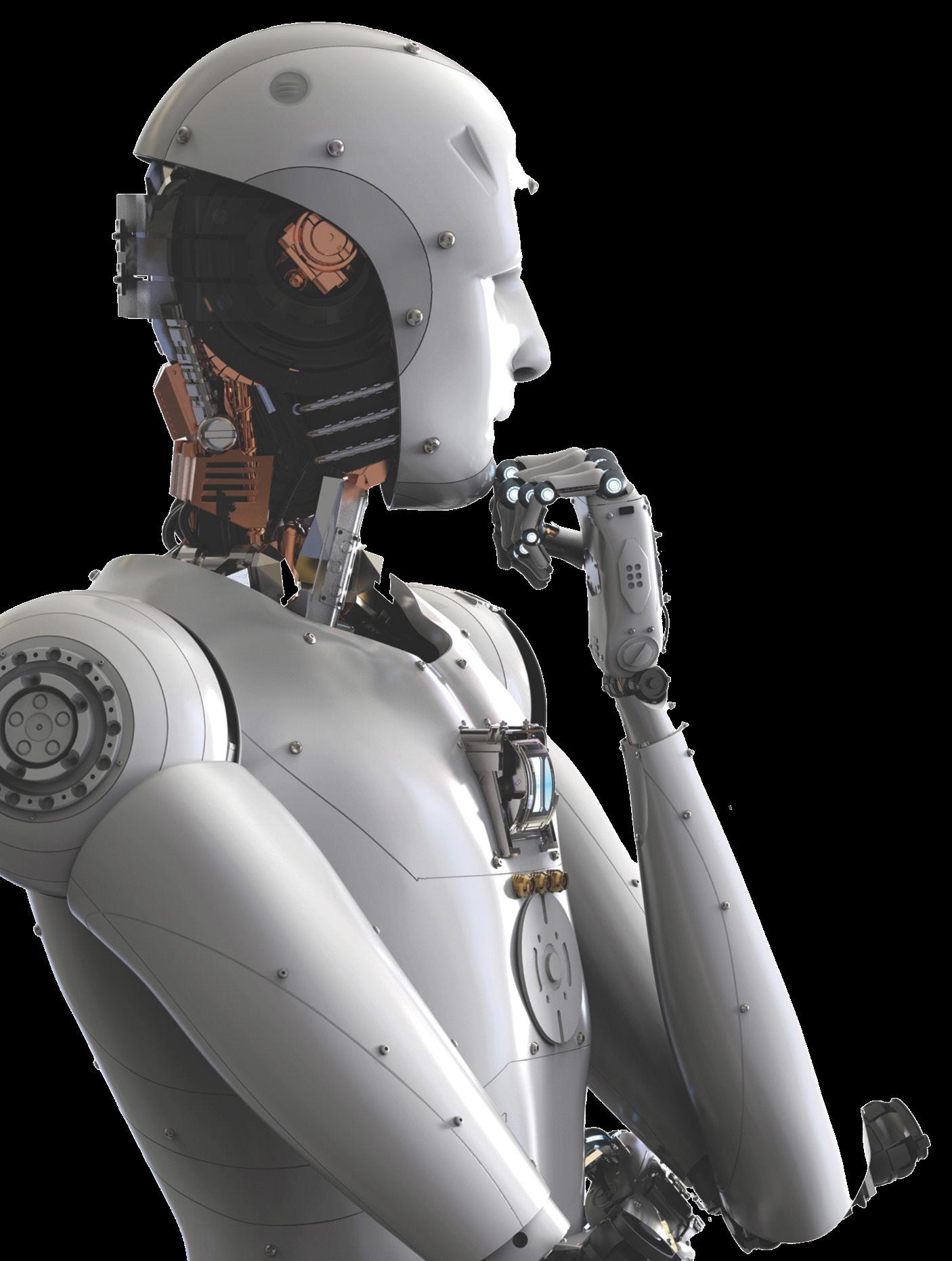
The event provided both inspiration and provocation, revealing how robotics can drive greater efficiency, creativity, and societal benefit if harnessed with care and foresight.
Such momentum created by the most ingenious technology is the perfect prelude to the Robotics Summit planned for May 27-28, 2026, at the Boston Convention and Exhibition Center. And while the recent foray into new technology was inviting and educational, the Summit will likely be labeled as a gathering of the best and brightest for a spectacular interactive affair that will present the most cutting-edge advancements in the field of robotics and extended services.
Visionaries, technologists, and investors will gather with global leaders, startups searching for Venture Capital (VC), and policymakers will meet and learn of the up-to-date ground plan for addressing not only technical breakthroughs but also the societal questions robotics presents.
The future is arriving swiftly—and actively inviting participation by all. The Robotics Summit offers a unique, if not once-in-a-lifetime, encounter with pioneering solutions, networking with forward-thinking individuals, and a chance to experience what up until now has only been a fantasy on the big screen.
To register for the Robotics Summit or learn more, contact MassRobotics at info@massrobotics.org. Become part of the movement and help shape the future of Boston— and the world. H
Get ready, winter lovers! Snowbound Expo returns to Boston this November 14-16, 2025, at the Boston Convention & Exhibition Center to kick off the 2025–2026 snow sports season with excitement, inspiration, and unbeatable deals. This three-day celebration will transform the heart of Boston’s Seaport into a snowy wonderland of discovery, connection, and anticipation for the winter ahead.
Whether a seasoned skier, a snowboard enthusiast, or simply curious about the mountains near and far, the Snowbound Expo is New England’s premier winter sports event, drawing over 22,000 passionate visitors annually. It’s a one-stop opportunity to explore the latest gear from over 250 top brands, including ski and snowboard equipment, cutting-edge apparel, accessories, and technology that can upgrade any winter adventure.
This year, the Colorado Ski Shop returns as the Official Retail Partner, delivering an enormous selection of gear and apparel—valued over $2 million—available for purchase on-site with exclusive expo discounts up to 70 percent off. Imagine walking away with skis, boots, bindings, and snowboards at the best prices you’ll find all season long— perfect to gear up just in time for the freshest powder and longest days on the slopes.
The Expo is more than just equipment and winter fashion shopping. It’s a vibrant community event packed with thrilling live shows like the Flippenout trampoline displays, interactive zones such as the new Epic Pass Winter Arcade, and Snowboard Zone hangouts featuring athlete signings and demos. Families are warmly welcomed with a dedicated Kids’ Zone where children under 12 attend for free when accompanied by an adult. Plus, beginners can try skiing onsite with expert guidance from local mountain instructors.
lineup of world-class speakers—from Olympians to local mountain legends, sharing stories, tips, and adventures on the Ikon Pass Inspiration Stage. These sessions are included with your ticket and offer a unique chance to connect with leading voices in winter sports.

Taking a long weekend to experience the show and other adventures Boston offers? Overnight visitors can find special hotel rates arranged exclusively for Snowbound Expo attendees—details are available on the official website for your convenience.
EVENT HOURS
Friday, November 14 | 2:30-9 p.m.
Saturday, November 15 | 10 a.m.-8 p.m.
Sunday, November 16 | 10 a.m.-4 p.m.
To learn more, purchase tickets, or explore special offers and hotel packages, visit the official Snowbound Expo website at snowboundexpo.com or email info@snowboundexpo.com.
Ignite your winter passion—Snowbound Expo Boston is where the season begins and memories are made. H

The mountains are calling! October is the perfect time to experience the magical fall foliage, delicious dining, and boutique shopping, as well as outdoor adventures—all wrapped up in authentic New England charm. With vibrant red and gold leaves painting the scenery, Littleton transforms into a wonderland for hikers, foodies, shoppers, and explorers seeking both the classic and quirky sides of New Hampshire hospitality.
Situated in the heart of the White Mountains and easily accessible by major highways, Littleton’s stunning natural backdrop comes alive every October. Artists Bluff, just minutes away, offers one of the region’s premier hikes, where panoramic views across Echo Lake and the surrounding hills are ablaze in color. For those craving grander sights, drive to the legendary Mount Washington Hotel or cruise along riversides dotted with brilliant colors, with each outing revealing more of the season’s beauty each day.
Walkable and offering a treasure trove of discoveries, Littleton’s Main Street is a delightful blend of old and new. Classic brick buildings house quirky new boutiques, time-honored shops like America’s Oldest Ski Shop, artisan galleries, and gift stores, along with the world’s longest candy counter for the kid at heart. Window shopping and wandering never go out of style in this historic town; every block brings tempting displays and the friendly smile of local shopkeepers. Whether searching for outdoor gear, crafts, unique books, antiques, or gourmet finds, Littleton’s shops invite visitors to linger and discover.
Hungry wanderers will find plenty to savor, from diners and exotic food choices from afar, to coffee houses, wine bars, and breweries, the modern and historic pubs and tap rooms offer a warm respite on cool autumn days and evenings. As for those whose palate may seek a touch of d’élégance, a scenic journey to the Mount Washington Hotel dining rooms will bring joy and satisfaction from both its décor and menus.
For a truly “off the beaten path” experience, visit The Loading Dock. This creative arts space hosts live music, comedy nights, art exhibits, and open mics, welcoming visitors of all ages into Littleton’s vibrant cultural scene. The Loading Dock exemplifies the community-driven spirit—where new talent, seasoned performers, and spontaneous fun keep evenings lively and memorable.
Littleton offers cozy inns, modern hotels, and charming B&Bs minutes from all the action. Whether booking a riverside room or a historic suite, guests enjoy comfort and convenience close to town and wilderness adventure alike. Plus, shopping in New Hampshire is tax-free—making every purchase a little sweeter and giving one more reason to plan a fall escape.
Littleton is ready for you this October. Leafpeepers, foodies, nature lovers, and seekers of unique entertainment will find memories waiting around every corner. Answer the call—explore, relax, and delight in a season you won’t forget! H

October 31, at the W Hotel Ballroom— Halloween Night!
Step into the night and become engulfed in mystery, desire, and secrecy, entwined with passion left bubbling since Tom and Nicole donned masks for a special occasion at the mansion.
Boston invites you to reclaim your senses and experience the sensual thrill of the unknown and perhaps the unmasked.
Inspired by the provocative world of Kubrick’s iconic film, with the same name, this exclusive event is wrapped in an intoxicating veil of allure and enigma; veiled faces conceal hidden intentions, while whispered promises linger in the shadows. Here, glances hint at untold stories, and every movement becomes a dance between reality and fantasy. The night invites you to explore the depths of your imagination, where temptation is both a question and an answer, where the air pulses with anticipation but leaves desire tantalizingly unfulfilled.
As the mask is lowered and the music rises, surrender to the erotic rhythm that awakens the senses and quickens the pulse.
It’s a place where boundaries blur, identities are defined, and passions are palatable.
Pass on the sports bars, fairs, and festivals, and allow yourself to experience a labyrinth of elegance, sophistication, and fantasy: sophistication and fantasy; it’s a grand ballroom inviting all to roam free with their ‘eyes wide shut.’
Join us for this rare treat—a beautiful mystery awaiting behind the mask. H
To be invited or for more information, go to eventbrite. com/e/eyes-wide-shut-halloween-masquerade-ball-w-hotelballroom-tickets-1665205828459?aff=ebdsshcopyurl
Friday, October 31, 9 p.m. to November 1, 2 a.m.
W Hotel Boston 100 Stuart Street Boston, Massachusetts, 02116
617-261-8700
Produced by Dope Entertainment
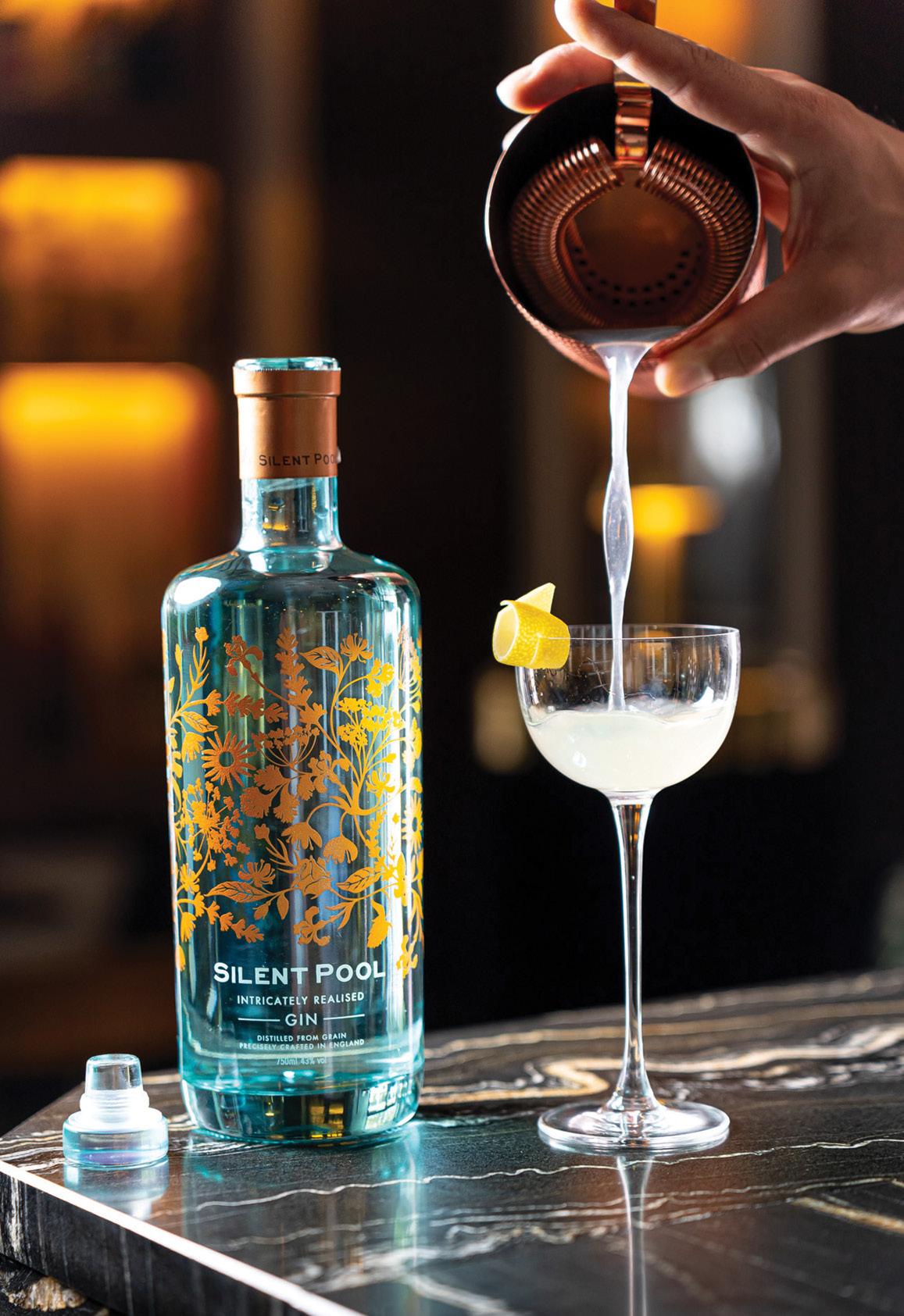
THE GHOST OF SURREY, A TALE OF ALCHEMY, AND A TASTING OF SILENT POOL GIN HIGH ABOVE BOSTON’S LUXURIOUS NEWBURY
It was a perfect and idyllic day as I strolled through the Public Garden, the air was crisp, and the sun shone brightly; I crossed the treacherous throughway known as Arlington Street and made it safely onto Newbury, where I entered the nearly hidden vestibule of the worldrenowned Contessa restaurant and lounge. Its private lift sent me up 17 stories to an elegant dining room and lounge; its panoramic views of the Boston skyline was breathtaking, and the sophisticated atmosphere gave notice that today’s event was orchestrated. The relaxed and composed setting intentionally mirrored the unique character and style of my purpose for being there, for today, I was invited to a private tasting and review of the English spirit known as ‘Silent Pool’ Intricately Realized Gin.
After a brief reintroduction with Laura, the company’s Northeast Brand Ambassador—a title more fitting than “representative” due to her palpable passion for the product, and whom I had recently made acquaintance with in Newport, we quickly passed on formalities and accepted two generous pours of the spirit—neat. The experience, more than just a handshake and a gargle, turned into an immersive journey deep into the heritage and traditions that define gin, but particularly, Silent Pool, having a close connection to a legacy dating back to the 17th century in Holland.
According to the company’s website, literature, and my lengthy conversation with Laura, I learned that the story begins at Surrey Hills of England, a land of verdant valleys and ancient, whispering woods, where a secret flows from a legendary spring and finds its way into one of the most remarkable gins ever to be crafted. To understand Silent Pool Gin, one must first learn of its source—a place of myth, mystique, and uncompromising craftsmanship that embodies both the ruggedness of the earth and the delicate elegance of its botanicals.
Tucked away on the Duke of Northumberland’s Albury Estate, Silent Pool Distillery is more than a mill where spirits are made; it’s a testament to the power. The distillery’s name is taken from the nearby spring-fed lake, the Silent Pool, a body of water with a history as deep and murky as its aqua-green depths. The legend, as local lore tells it, speaks of a tragic tale involving a woodcutter’s daughter who drowned in the pool to escape a knight’s advances. Her ghost is said to still haunt the area, forever leaving the pool with an eerie, captivating quietness. It’s a powerful narrative that imbues the gin with a unique and haunting beauty, a story subtly woven into the intricate illustrations on the bottle and decorative metal container.
Silent Pool Gin began in 2013 when a group of friends, drawn together by a shared passion for crafting, decided to create a new type of distillery. Their vision was to produce handcrafted, artisan spirits with an uncompromising commitment to quality and sustainability. Inspired by the way Scottish whisky brands tell a story through their regional identity, the founders set out to create a truly English gin that would encapsulate the outstanding natural beauty of the Surrey Hills. They meticulously transformed a cluster of dilapidated farm buildings into a modern manufacturing hub, where every aspect of the operation was considered, from the bespoke machinery to the holistic production philosophy.

Silent Pool Gin stands apart as a quiet classic, a testament to its creators’ dedication to their craft. Their philosophy is driven by a deep respect for the environment that surrounds them. The distillery’s large still, affectionately named Ophelia, is powered by a vintage wood-fired steam boiler, and they’ve even begun to use Hydrotreated Vegetable Oil (HVO) to reduce greenhouse gas emissions by up to 90 percent. They have a closed-loop cooling system for their stills that recycles heat to reheat the still for the subsequent distillation. Their commitment to sustainability extends to the most minor details, from using local hardwood to power their boilers to composting and recycling their waste. They’ve even partnered with local businesses to turn unwanted or “wonky” fruit into liqueurs and have introduced a refill service for customers to reuse their striking bottles. Here is a brand that is as conscious of its carbon footprint as it is of its flavor profile.
This dedication to process is what sets Silent Pool Gin apart; the method involves a “mosaic approach.” It is a four-stage process that treats each of its 24 carefully selected botanicals with the respect they deserve, coaxing out the most vibrant and complex notes. The process begins with the Maceration Stage, where the robust base botanicals—including Bosnian juniper berries, coriander seeds, and cubeb—are steeped in a neutral grain spirit for 24 hours. This initial stage lays the foundational, more powerful notes that provide the gin with its backbone.
The second stage is a unique “Gin Tea Infusion.” It’s here where the delicate, ethereal botanicals are handled. Rather than macerating them with the rest, floral notes like rose petals, lavender, chamomile, elderflower, and linden flower are placed in a giant tea bag and separately infused in a high-proof spirit. This method prevents the gentle flowers from “cooking” in the still, stripping the oils and aromatic compounds while preserving their delicate character. The strained essence is then added to the main pot, lending the gin its high notes of perfumed lime and floral elegance.
The third stage involves Vapor Infusion, using a head basket that hangs in the neck of the Holstein still. As the spirit vapors rise during distillation, they pass through a selection of fresh and dried botanicals, including Macedonian juniper berries, fresh orange and lime peel, and dried pear. This process imparts lighter, more volatile aromas, adding a bright and zesty layer to the gin’s profile. Finally, just before distillation begins, a handful of botanicals— including bergamot and honey—are added directly to the pot.
BY STEVEN CHAN
This fourth stage ensures the spirit has a rounded, viscous mouthfeel and a touch of sweetness that beautifully ties all the disparate elements together. The result is a truly intricate spirit, meticulously layered to create a harmonious whole.
And what of the finished product? As the clear liquid glistens in the glass, the nose is met with a soft, honeyed sweetness, followed by a whisper of floral notes. It’s an elegant, almost perfume-like introduction that promises a gentle experience. The first taste, however, is a fascinating and complex surprise. The sweetness on the nose gives way to a clean, rich, and full-bodied spirit. The initial floral notes of elderflower are present, but they’re quickly balanced by a burst of bright citrus and a warm, sophisticated spice from the cubeb and grains of paradise. There is a rugged, earthy strength of the juniper serving as a steady undercurrent, a bold anchor that allows the more delicate, refined grace of the 24 botanicals to play out on the palate.
The taste journey is one of subtle shifts and layered flavors; it’s far from a simple, single-note gin. With each sip, new elements emerge, from the slight warmth of cardamom to the faint, lingering sweetness of honey. It’s a spirit that encourages you to take your time, to deconstruct the flavors, and to appreciate the craftsmanship behind the blend. The finish is long, clean, and satisfying, leaving a lingering impression of sophisticated balance and understated charm.
Silent Pool Gin is also celebrated for its versatility. While it is certainly pure enough to be enjoyed neat or over ice, its complexity delivers a perfect canvas for classic cocktails. The brand’s signature serve, a simple gin and tonic with a twist of orange peel, is a testament to how the right garnish can elevate its existing citrus notes. For those who prefer a richer, more complex drink, a classic martini with a dash of dry vermouth highlights its elegant

botanical layers. Of course, there’s the “Bee’s Knees” cocktail, crafted with Silent Pool Gin, lemon juice, and honey water, which pays homage to the local honey used in the distillation and creates a beautiful, harmonious synergy of flavor.
In a market crowded with fleeting fads, Silent Pool Gin stands as a quiet classic. It’s a spirit with a story, a sense of place, and a taste that is as enchanting as the legend that inspired it. It’s for those who appreciate the craftsmanship behind the bottle and the timeless luxury of a beautifully told tale.
Ultimately, Silent Pool Gin proves that a gin can be both powerful and delicate, complex and balanced—a masterful blend of tradition and modern artistry, distilled with a true sense of place. H For more information or to purchase, visit silentpooldistillers.com or visit your favorite retailer.


In a few short months, the Village Sweet Shoppe has become one of the most visited stores in Village of Padanaram in South Dartmouth. Offering the highest quality choices and cheerful services, it's the place that puts everyone in a good mood and makes them smile.
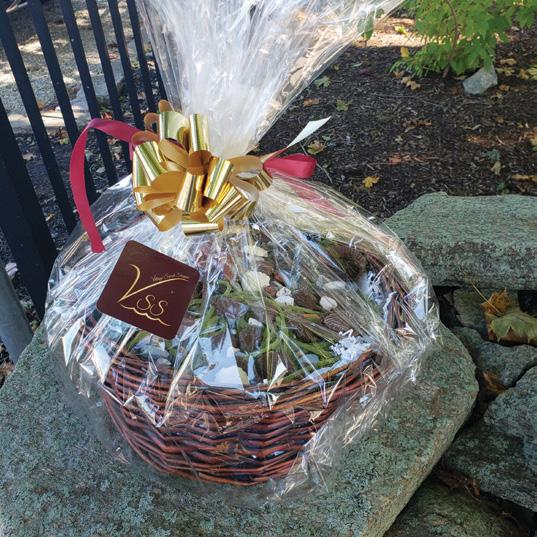

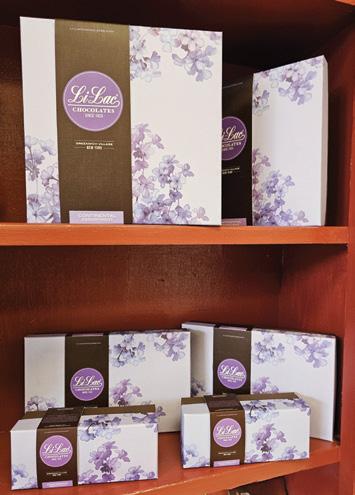
The Village Sweet Shoppe is the go-to place for the finest in tasteful gifts including names like Li-Lac Chocolates from NYC, Harbor Sweets, Phillips Chocolates, Mc Crea's mouth-watering caramels, and treats from the Ice Cream Factory.

And, for those with eclectic tastes, we have an intriguing collection of international favorites that will satisfy most decerning palates.

Are you looking to relive old memories or introduce a new experience of a traditional style ‘candy store’ to the grandchildren? Perhaps you need a special gift or theme for a party to show your appreciation? Of course, you might be craving chocolate, and that's why we're here! Taste, Texture, & Quality Is Assured
300 Elm Street
‘In the Village’ South Dartmouth, Massachusetts





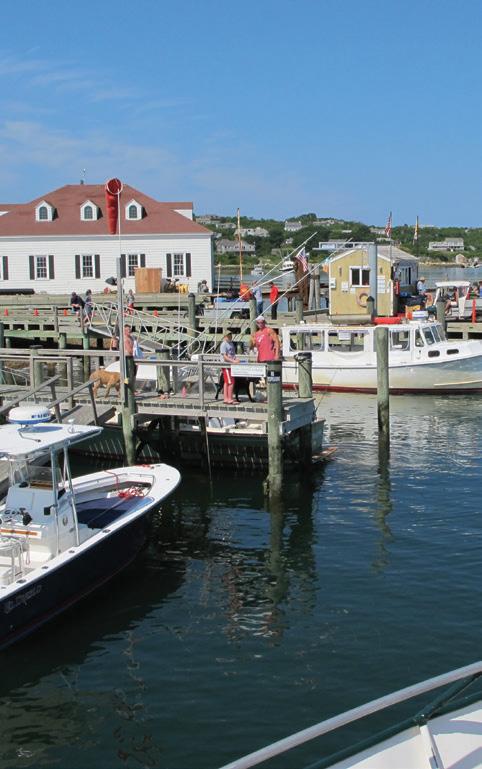


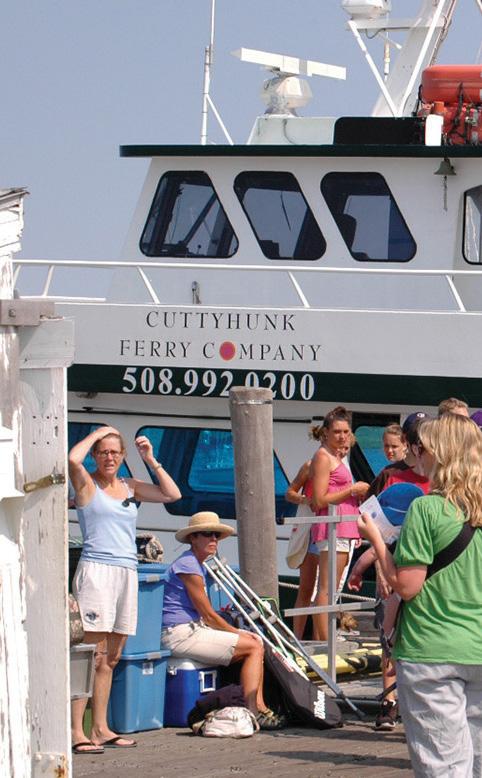
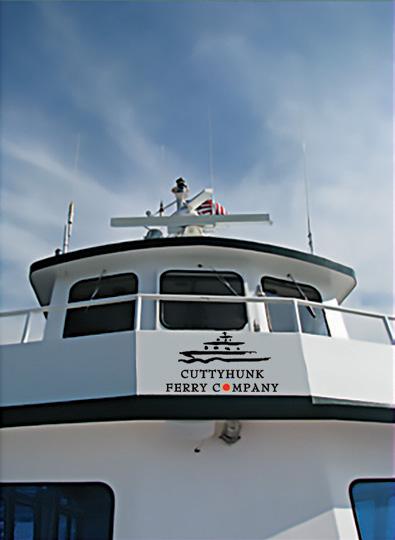
• Depart from New Bedford’s historic waterfront; a short walk to downtown New Bedford’s many restaurants, boutique shops, museums & galleries.
• Enjoy the gorgeous views of Buzzards Bay as you make your way to the laid back island of Cuttyhunk.
• Friday Night Sunset Cruises! Breathtaking scenery, comfortable accommodations, not to be missed excursion.
CuttyhunkFerryco.com
FALL: SEPTEMBER 22, 2025-OCTOBER 13, 2025
WINTER: OCTOBER 14, 2025-APRIL 27, 2026 - CALL FOR ADDITIONAL HOLIDAY TRIPS
Depart New Bedford
WEATHER NOTE: IF SEVERE WEATHER IS PREDICTED, IT IS ADVISABLE TO CALL IN ADVANCE OF DEPARTURE FOR POSSIBLE SCHEDULING CHANGES. 508.992.0200
To get a ticket you must have a reservation through our online reservation system. No charge for children 2 years and younger. The office must be notified at the time of ticket purchase about each child 2 years and under that will be traveling with you, in order to accurately count all persons on board the vessel. Dogs, on leash, are welcome at no charge. For non-web or special group payments and for check, cash or different form of payment, please email reservations@cuttyhunkferryco.com or call 508.992.0200. You can leave a message and your reservation will be held.



